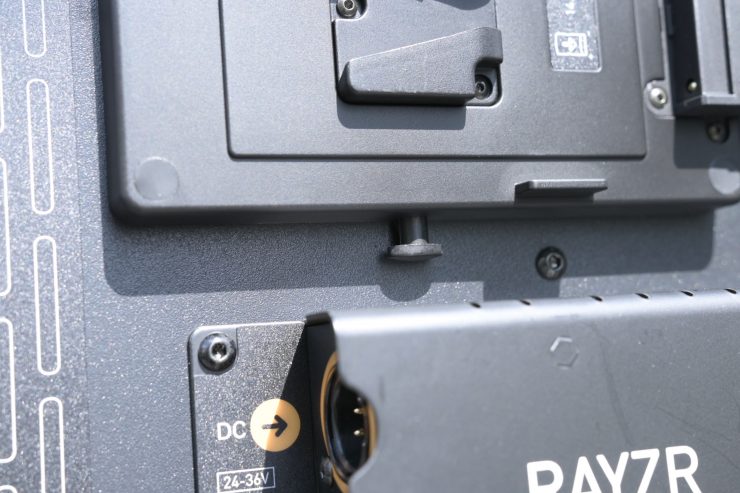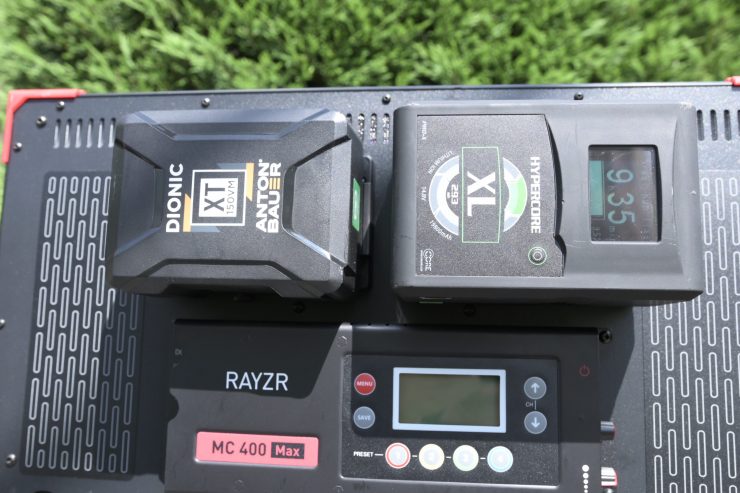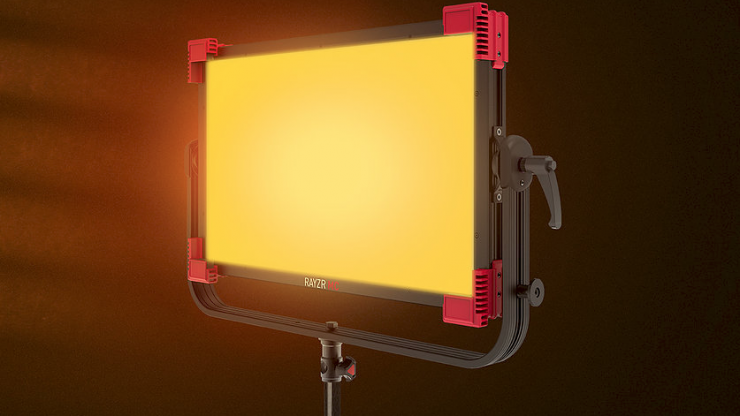
The Rayzr MC 400 MAX is a high output 2×1 sized RGBWW LED light that can be run off camera batteries.
I have reviewed a couple of the Rayzr MC lights previously so let’s see how the MC 400 MAX measures up.
The MC 400 MAX is the fourth light in the series
The MC 400 MAX joins the MC 100, MC 120, and MC 200 in the Rayzr RGBWW series. I previously reviewed the MC 120 and MC 200 on the site and found that both fixtures performed well and offered very good value for money.
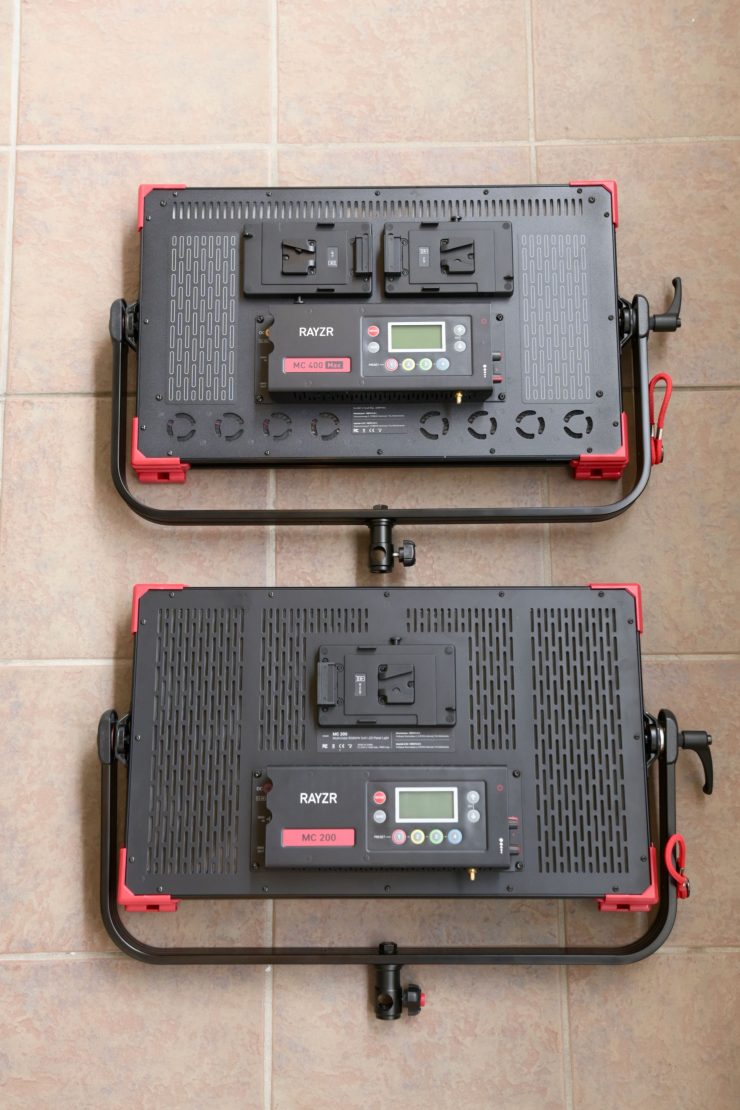
The MC 400 Max has the same dimensions as the MC 200 but Rayzr claims that it has double the output. Above you can see that they look fairly similar.
RGBWW
We are seeing a lot of lighting companies now using RGBW technology. RGBW stands for Red, Green, Blue & Warm White. There are, however, other types of RGB such as RGBWW and RGBAW. The MC 400 MAX uses RGBWW, which consists of 5 chips, not 4. The extra chip means the Rayzr MC lights not only have a warm white chip, but also a white chip. This is different to say the ARRI SkyPanel where they are actually mixing colors to obtain white. RGBWW can also be found in lights such as the Litepanels Gemini.
While in theory, an RGBWW LED should be better at creating color mixes, it requires significantly more cooling than a regular RGB LED.
Operating Modes
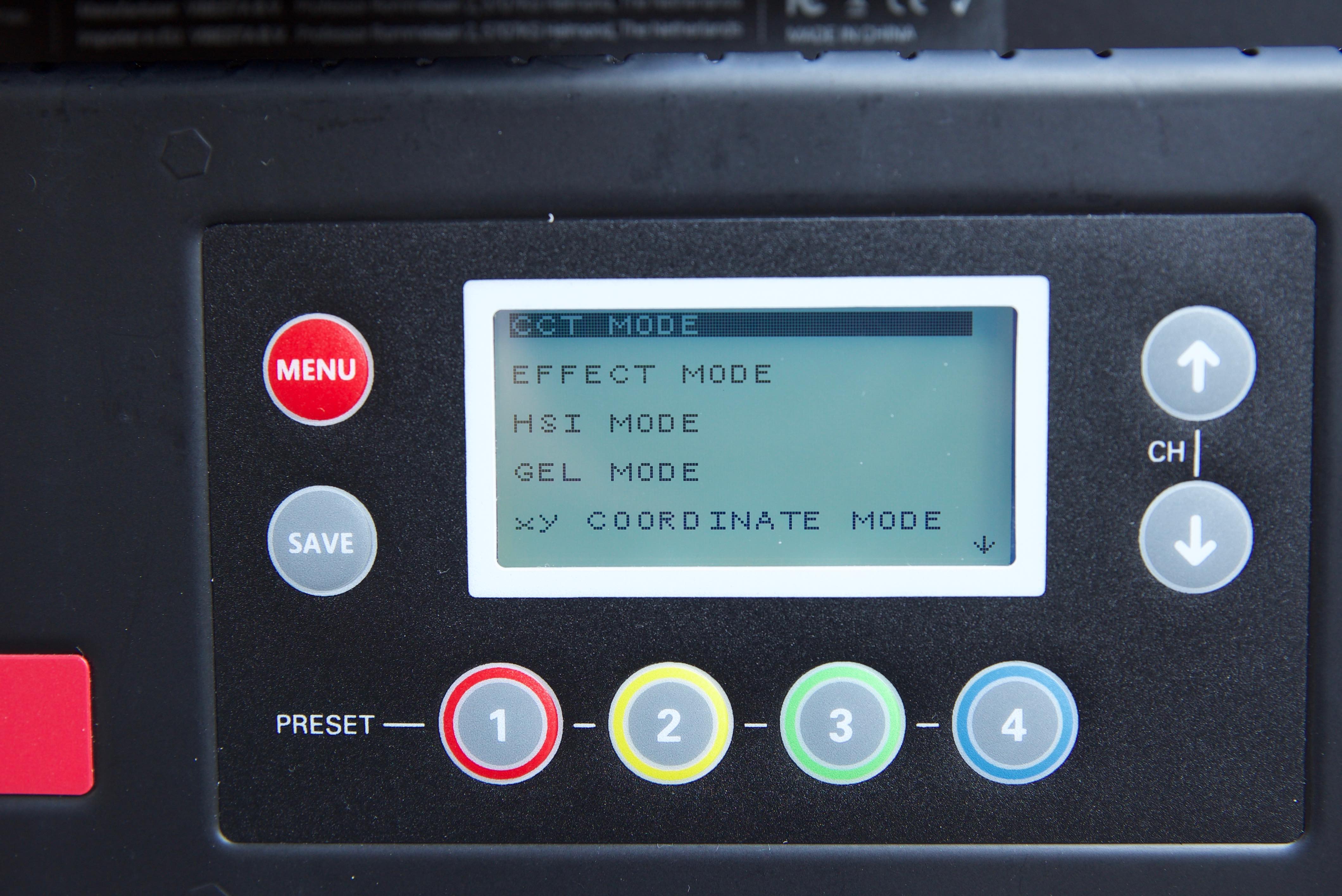
The operating modes and features of the MC 400 MAX are identical to those of the MC 100, MC 120, and MC 200. For those who are not familiar with those lights, I’ll still run through everything. If you are familiar with the MC series you might want to skip ahead in the review.
Rayzr MC 400 MAX Lighting Modes
- Color Temperature (CCT) Mode
- HSI Mode
- X, Y Coordinate
- RGBWW Mode
- Gel Mode
- Effects Mode
CORRELATED COLOR TEMPERATURE (CCT) MODE
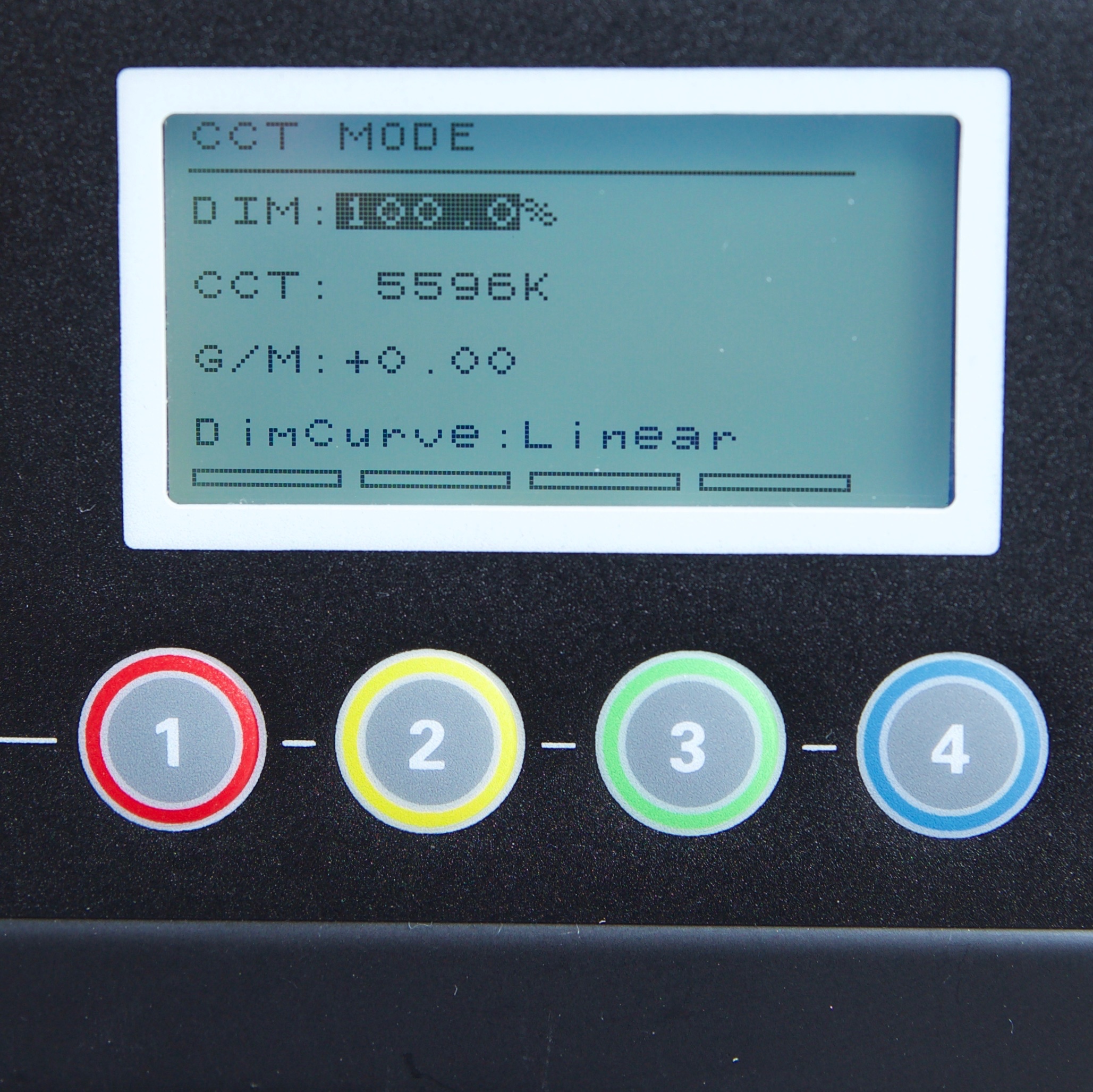
This is the mode most people are going to use the light in. In the CCT Mode, you have full access to making Kelvin color temperature adjustments between 2400K to 9900K. These adjustments can be made in small or large increments depending on which dial you use. You also have full +/- green adjustment available which is extremely handy.
Being able to dial in more or reduce the amount of green coming from your lighting source can make a huge difference. Different camera companies use different sensors in their cameras and they all react differently to light. Some camera sensors may lean towards magenta, and some, more towards green. By making CCT adjustments you can dial in the light so that it looks better for whatever camera system you are using. CCT adjustment also helps when you are tying to match lights from different manufacturers.
The Kelvin color temperature range is very impressive and the adjustment range is the largest I have seen so far on an RGBWW light.
HSI Mode
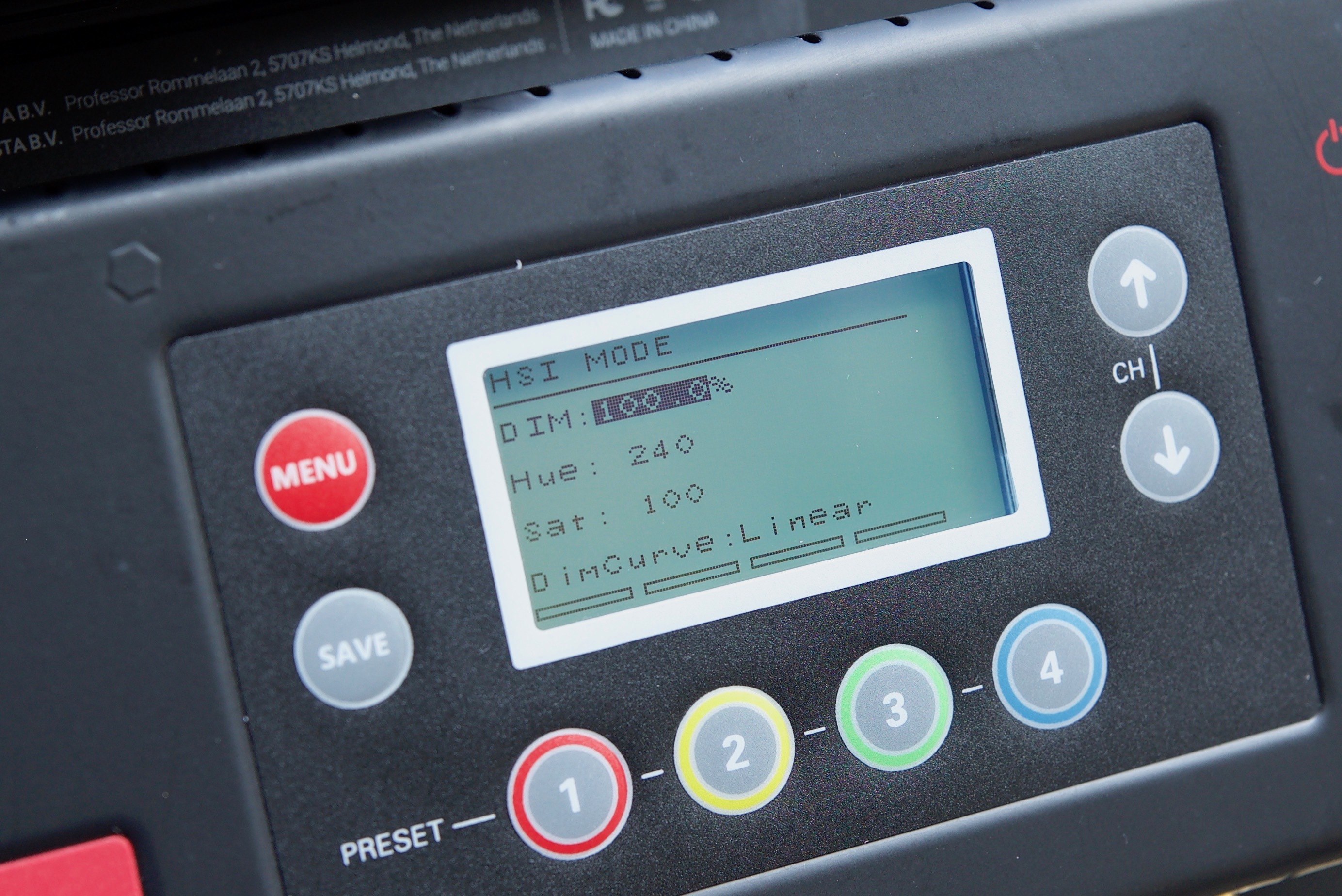
The HSI mode lets you create just about any color you can think of. It gives you full hue and saturation control as well as intensity. By manipulating, the hue and saturation you can create some really interesting colors that depending on the project you are working on can really add some creative flair. I quite like using this mode to create a lot of color separation between the foreground and background, or for recreating a really cold or warm looking image.
X, Y Coordinate
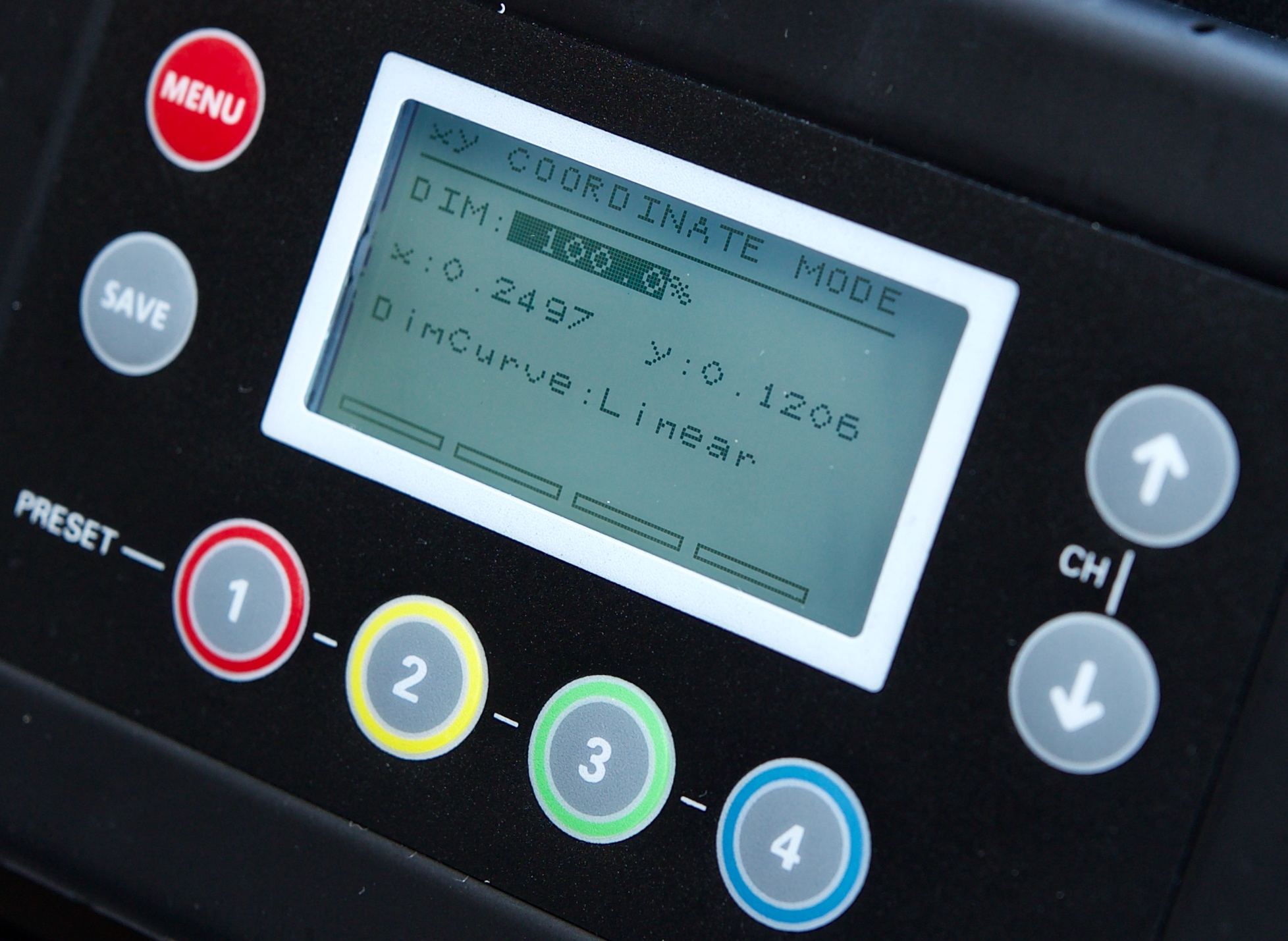
In this mode, you can create colors by changing the X and Y coordinate axis. This gives you more finite control for creating colors than using the HSI Mode.
Digital Gels
Inside the fixture, there are 300 Digital Gels. Rayzr claims that there is no light loss when using any of the gels. Having built-in Digital Gels not only means that you don’t have to physically carry gels around, but you can also quickly and easily replicate popular gels. Using the gel mode can help you match other lighting sources, especially if you are working with other lights with gels.
RGBWW Mode
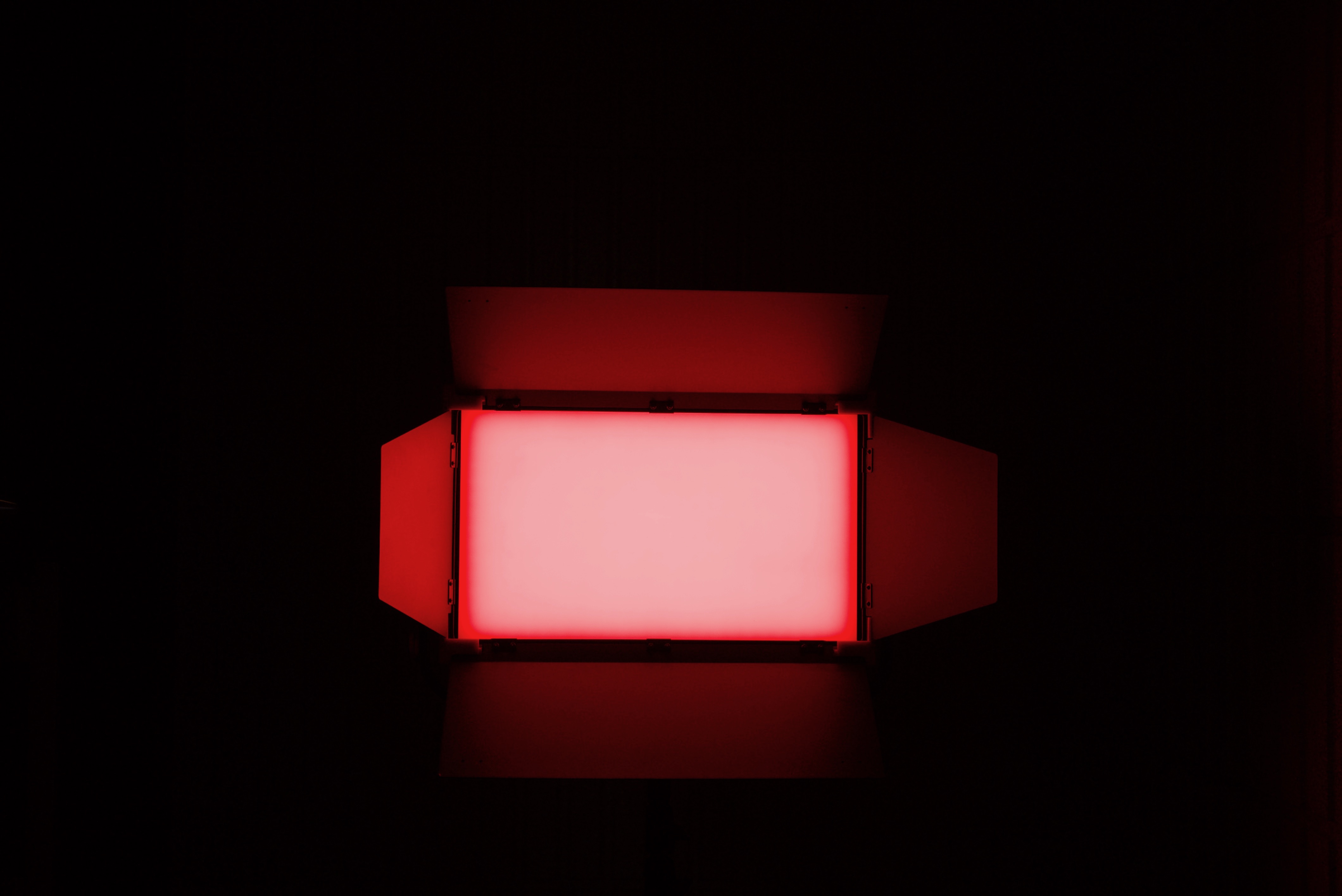
In his mode, you have full control over how much Red, Green, Blue, White, and Warm White are being used. This way you can mix various color combinations to achieve a certain color you are after.
Effects
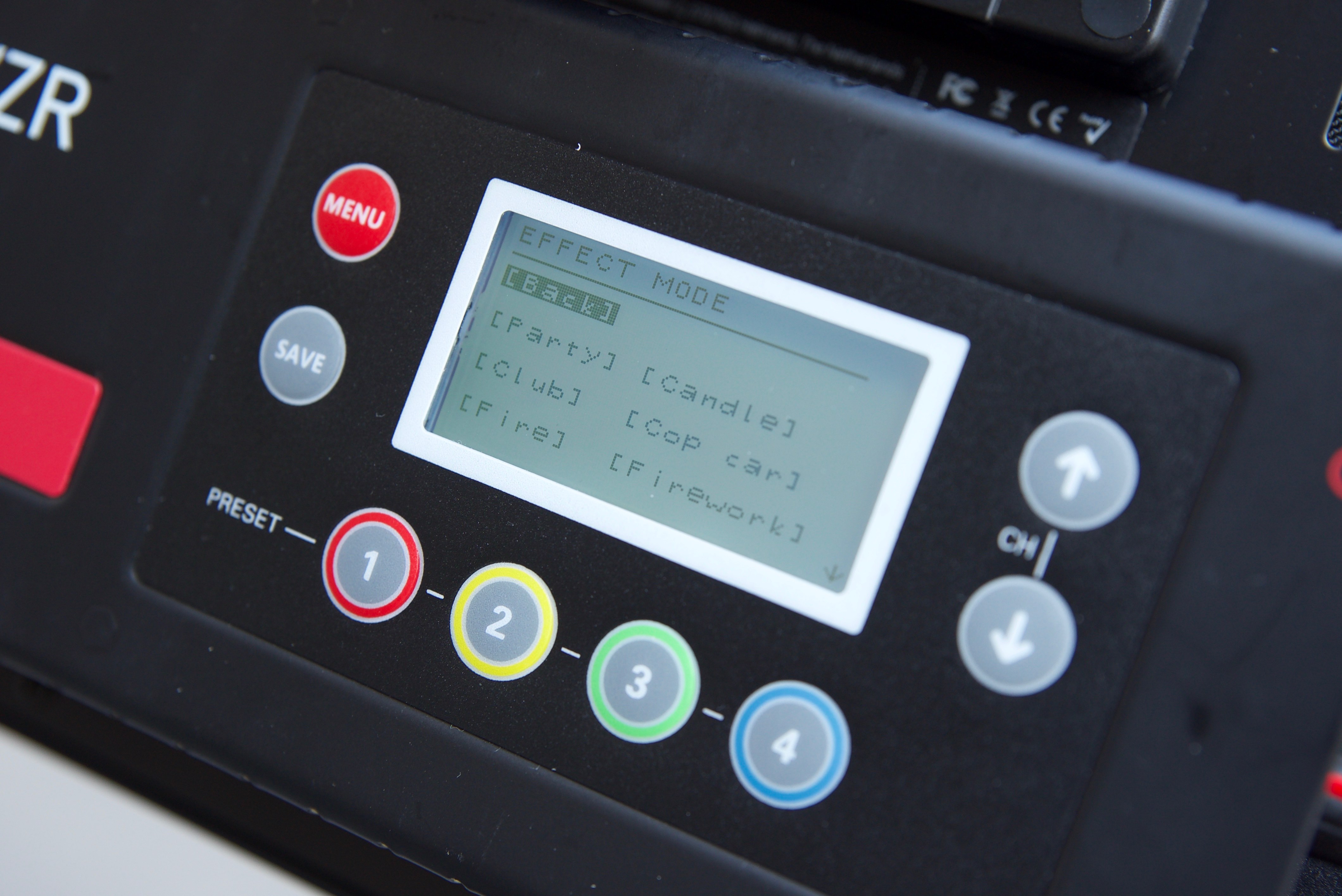
The Effects mode lets you recreate a wide range of lighting effects which can be handy for certain scenarios. The effects include:
- Party
- Candle
- Club
- Cop Car
- Fire
- Fireworks
- Light Strobe
- Lightning
- Television
All the effects modes can be individually adjusted and tailored to your lighting needs.
Are all RGBW lights starting to look the same?
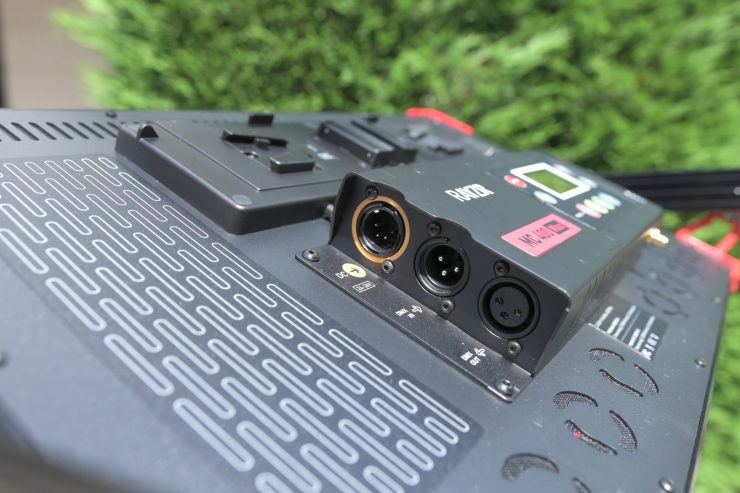
There doesn’t seem to be that much imagination from lighting companies. Most of today’s RGBW lights all seem to have the same or very similar feature sets. In fairness there is probably only so much you can do with current technology.
+/- green adjustment, hue, saturation and intensity (HSI) control, the ability to dial up gels, and lighting effects have been available in the Arri SkyPanel series since 2014 and quite a lot of other RGBW, RGBWW, and RGBAW lights for some time.
What we are starting to see, however, is that the prices of lights with these features have started to fall. The entry point for getting a high powered 2×1 RGBWW light that has a ton of features has never been cheaper.
Design
As far as the design goes, a panel light is a panel light. There are only so many ways you can design and build one.
The MC400 MAX shares the same styling and design philosophy as the other lights i the series, with one exception.
Unlike the other Rayzr MC fixtures, the MC 400 MAX doesn’t have its power supply onboard. While it does have the dual battery plates and control unit on the back, there is a separate large and heavy power supply that you need to use if you run the light off mains power.
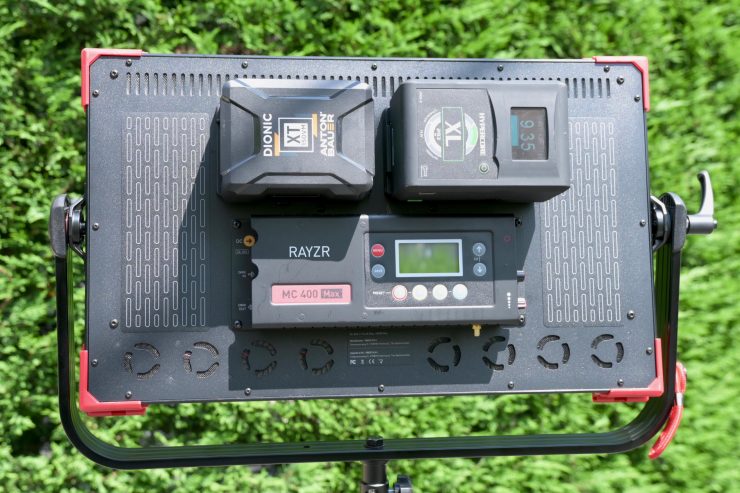
The MC 400 MAX is a self-contained unit if you want to run it from camera batteries, but not if you are running it off mains power. In one way this is good because you can just pull the lights out of a bag (albeit, a very large one!), put a couple of batteries on the back and you are ready to go.
If you want to run it off mains power then it no longer becomes a self-contained fixture.
It certainly isn’t going to be the most travel-friendly solution, but that pretty much applies to all high powered 2×1 sized lights.
I’m not the biggest fan of lights that consist of multiple components that you have to assemble and connect together. While it makes sense with lightweight fixtures that you can mount on arms etc. it doesn’t really make that much sense with a large, heavy fixture. For the MC 400 MAX, I would have preferred to have seen the company make a self-contained unit where everything is attached.
This is why I like the Litepanels Gemini 2×1 and the Lupo SuperPanel Full Color 60, because everything is attached to the fixture.
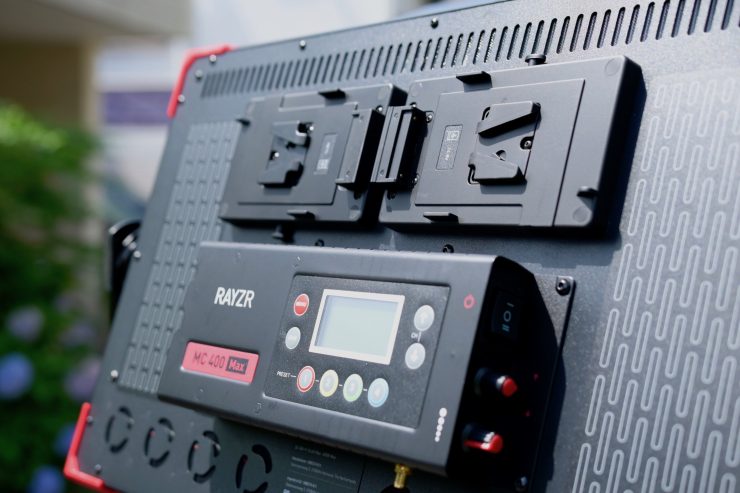
The control unit looks almost identical to those you would find on some of the Kino Flo lights, right down to the color and placement of the buttons. I personally don’t like when companies make products that are almost identical to someone else’s. Is there a reason as to why it looks so similar to a Kino Flo control unit? Well to find this out I asked Rayzr for a comment and I was told:
“Regarding the shape of the control unit and even the position of the display and buttons, this is already mainly decided by the position of the inputs and the board. Even though the design is similar, it’s by no means a copy, as the way to control the light is completely different from Kino Flo. We design the controllers in a way that we think makes sense for the user.”
Rayzr
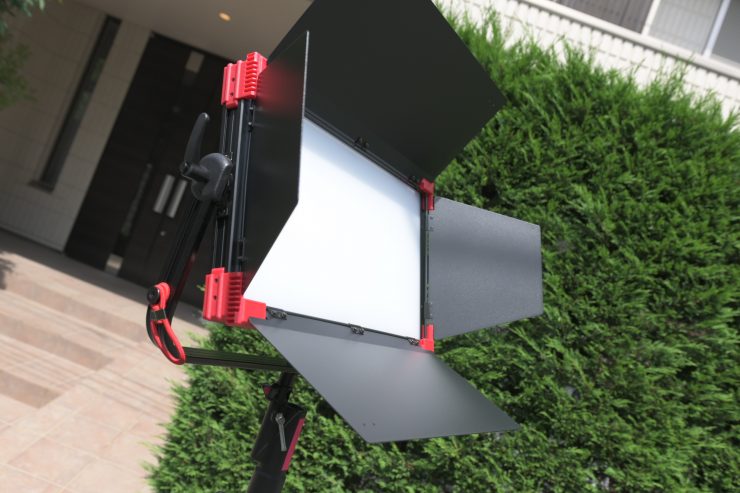
The lights all come with barn doors which is something you don’t normally get as standard. This is nice as it allows you to control the light spill and it certainly adds versatility to the way you can use it.
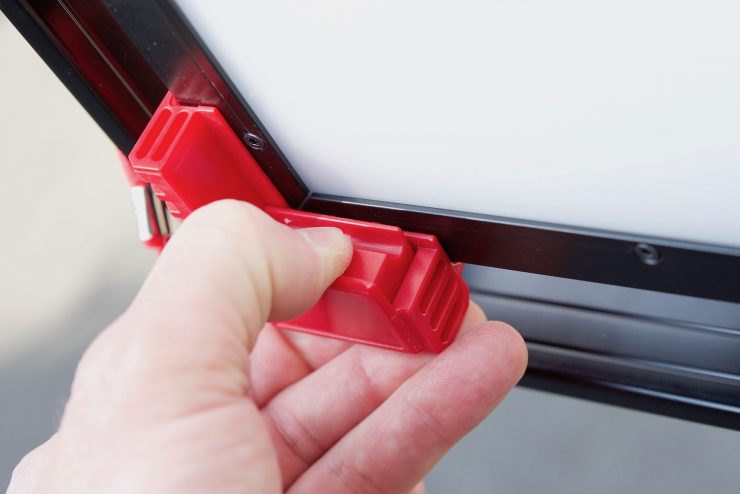
The lights also use a Quick Release Accessory System that lets you mount light shaping tools such as honeycomb grids, barn doors or a softbox. This is quick and easy to use. This system uses a simple spring mechanism and it makes taking off or putting on accessories like the barn doors very easy. It has been well designed and once your preferred light shaping tool is in place it won’t move around or rattle.
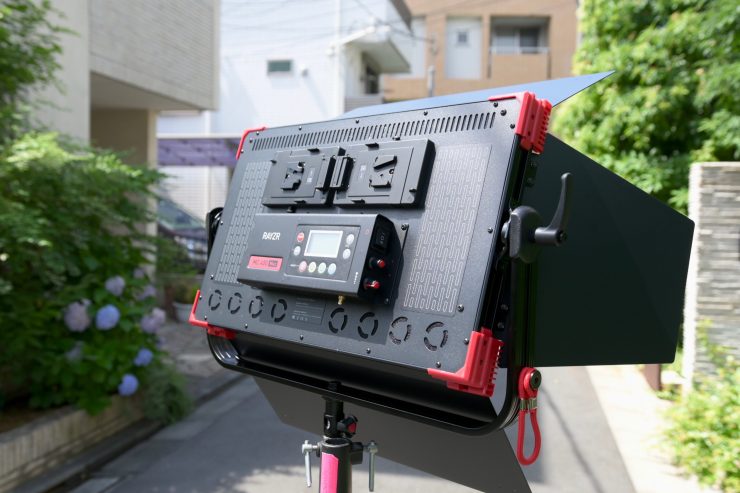
The MC 400 MAX has both wireless control as well as DMX. With WiFi and DMX built-in, the MC series is easy to control if you need to use them remotely. WiFi will work through a router, and Rayzr makes the platform compatible so that you can use any universal router. The WiFi will work with ArtNet so any App compatible to ArtNet like Luminair 3 can be used. It is important to note that Luminair will set you back $99 USD.
There are some other free DMX apps such as Photon that will also work with the Rayzr Router.
Controls and Menu System

I like the controls and menu system on the MC 400 MAX. Everything is easy to access, and the menu system is straightforward and easy to use. The buttons and dials are clear and easy to read and the in-built LCD display shows you exactly what you need to see. The dials have little notches on them so when you make adjustments you get a nice tactile feeling.
Preset Buttons
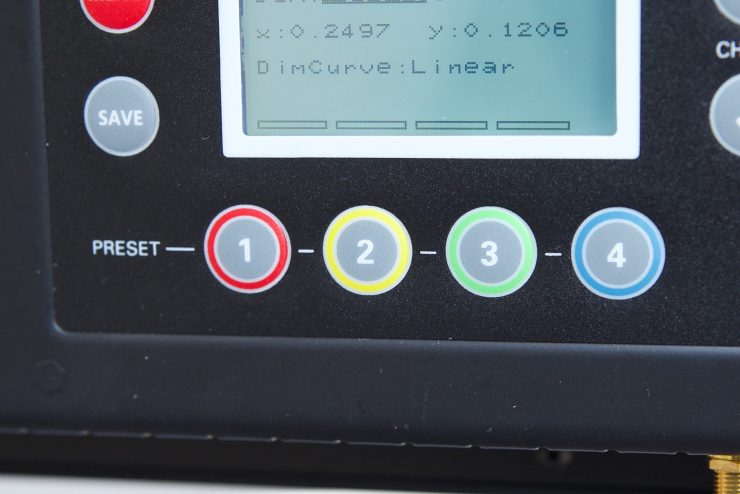
Just like all of the other MC series lights, the MC 400 MAX has four preset buttons that in the default mode are set as Kelvin color temperature presets: 3200K, 4500K, 5600K, and 6500K. You can save your own Presets but Rayzr have made this a little confusing. You can only save presets when you are in a particular mode. If for instance, you are in the HSI mode, you can only save various HSI settings and assign them to the presets. If you then move to say the CCT mode the presets are not the same as when you were in the HSI Mode. While there is nothing wrong with this, there is no way of knowing what you have set as presets in all of the individual modes unless you have a photographic memory. If you are going to store presets I suggest you write them down somewhere. or place some tape on the fixture and right what the presets are.
The nice thing about presets is that if you are working with certain cameras and you have pre-dialled in a look that you know works well with that camera, you can just store it and then bring it up the next time without having to adjust all the settings. This saves precious time and allows for accurate repeatability with your lighting.
Dimming Curves
Four user-selectable dimming curves provide fine-grained control in specific situations:
- Linear– being a 1:1 translation
- Exponential– providing fine control in the low end
- Logarithmic– provides fine control in the high end
- “S” Curve – is a combination of exponential and logarithmic
Build Quality
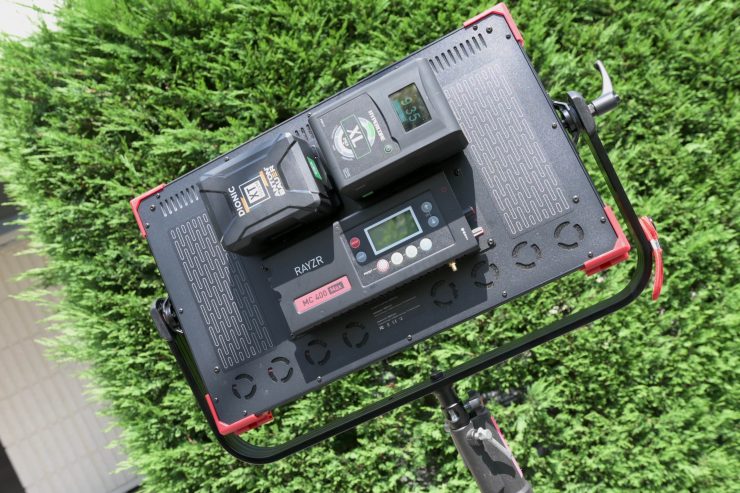
The MC 400 MAX is solidly made. The build quality is in line with the other Rayzr MC panels.
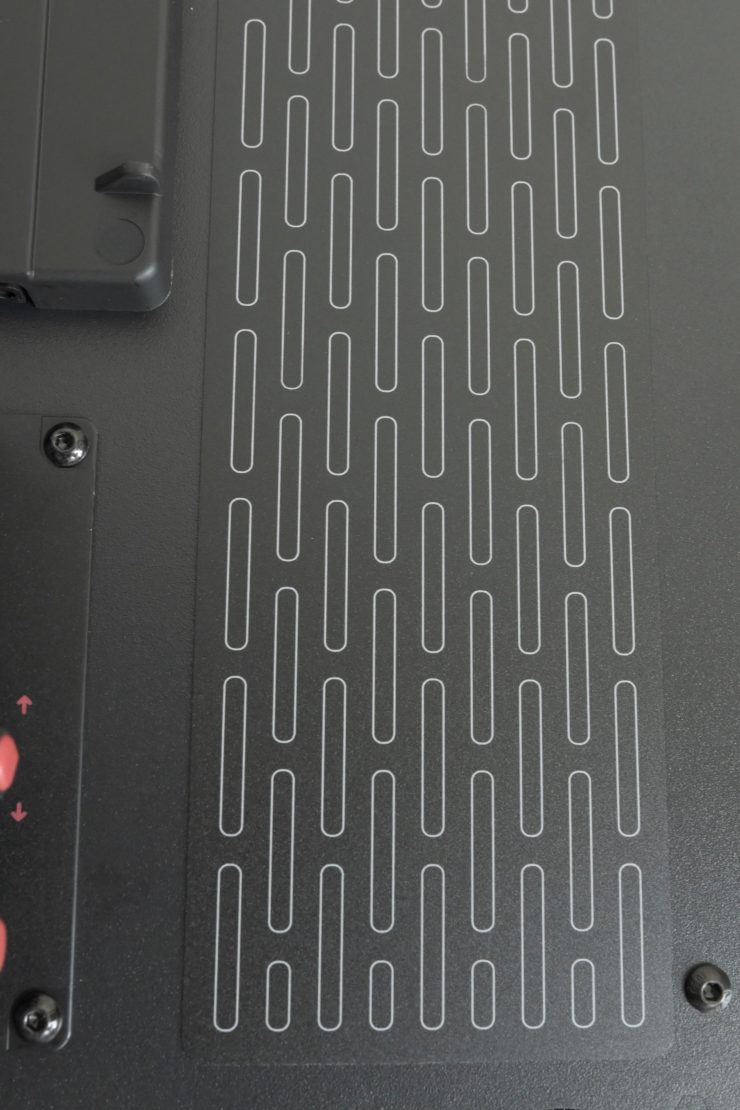
The lights housing is mainly constructed using an aluminum profile frame and all the dials and buttons have a nice tactile feel. I was impressed by the overall attention to detail and the quality of the finish.

The yolk frame is nice and robust and offers a full range of rotation. It locks off very securely and the tightening lever uses a type of grooved rosette connection so it won’t slip or move. The locking mechanism is one of the best I have seen on a LED light.

What I do like is that Rayzr has put two mounting points on the light stand receptor so you can mount the lights horizontally or vertically. I’m not sure why more lighting companies don’t do this.
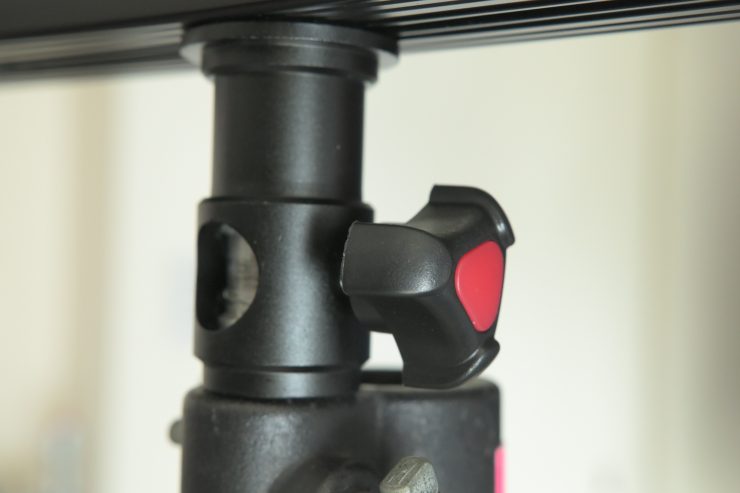
I do, however, think that the locking knob on the yolk frame is too small for a light this size. It is the exact same one that is used on all the MC panels.
The light doesn’t look that well suited for use out in the elements if it is raining or snowing for instance. There are a lot of exposed vents on the control unit and you wouldn’t want any type of liquid or moisture getting inside.
Even though it looks to be built really well it’s impossible for me to say how it would hold up over time.
How does it stay cool?
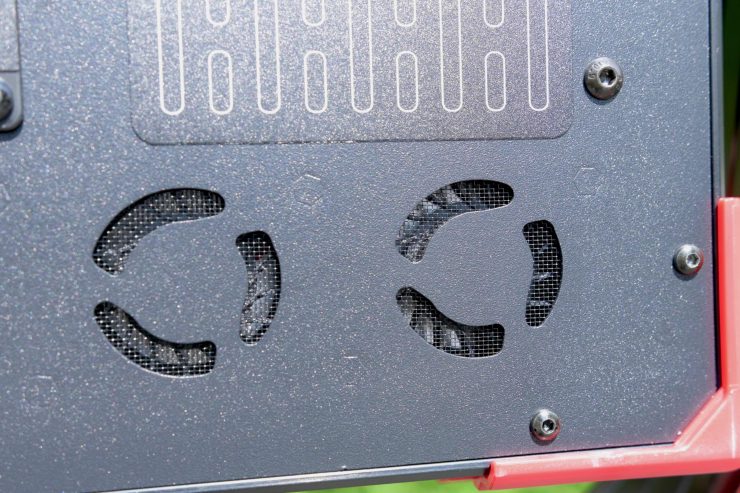
Large, high powered RGBWW lights get very hot and keeping them cool is not an easy task. Rayzr states that the MC 400 MAX uses eight ultra-silent active cooling fans to keep 400W of power in a cool and controlled environment for long term stability. This is different from the other Rayzr MC panels that rely on passive cooling.
The eight ultra-silent active cooling fans are certainly not “ultra-silent”. You can clearly hear the fans when the fixture is on, especially when you use it at 100% output. While they are not what I would consider loud, there is a chance they could be heard in quiet rooms where audio is being recorded.
I did also find that if you are running the lights for long periods of time the back of them does get hot. It’s not too hot that you can’t touch it, but it does get warm.
Size and Weight
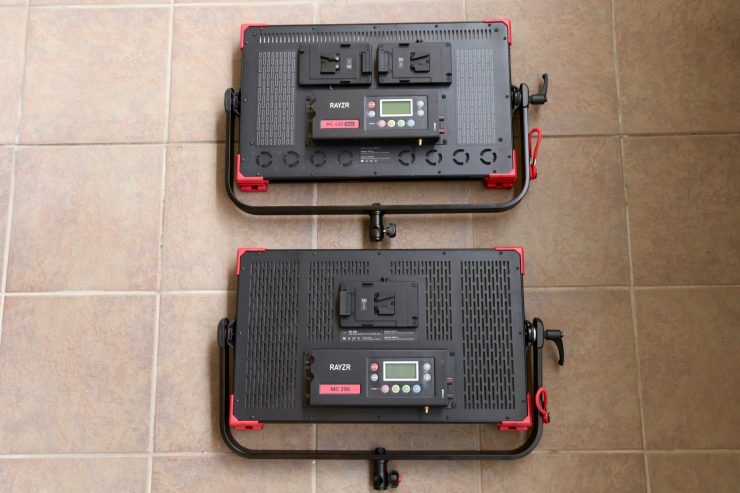
The panel itself has dimensions of 52.8 cm x 37.3 cm x 3.3 cm. If you factor in the yolk frame, power supply, and barn doors, etc. the dimensions are 63.2 cm x 45 cm x 9.3 cm. It has the same dimensions as the MC 200.
It weighs in at 8.3kg (10.14 lb). 8.3kg may sound like a lot, but you have to factor in that this includes the power supply, battery plates, barn doors, and the mounting frame.
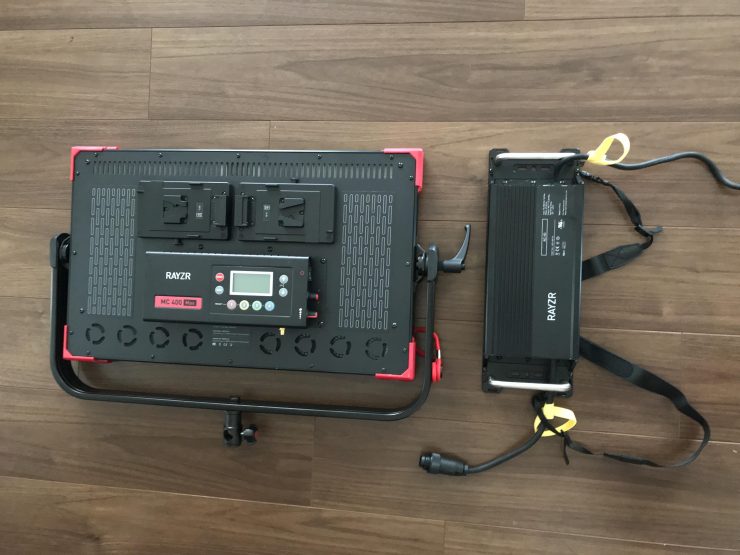
Unfortunately, if you want to power the light off mains power you need to use the large and heavy power supply that comes with the fixture. The power supply weighs in at 3kg (6.61 lb).
My gripe with the power supply is the cable is quite short, so if you have the light at a height above about 5 feet you need to attach the power supply to the lighting stand.
Rayzr does supply you with a strap for the power supply so you can attach it to a light stand. This strap does help create a bit of ballast so your light stand has better weight distribution.
If you combine the power supply and the MC 400 MAX, the whole system weighs in at 11.3 kg. This is more than the Litepanels Gemini 2×1, but a lot less than the ARRI SkyPanel S60-C.

In the case of the MC 400 MAX, this is how it compares to some other 2×1 style RGBW lights in terms of weight:
- Litepanels Gemini 2×1 10.1 kg (22.2 lb)
- ARRI SkyPanel S60-C 12 kg (26.5 lb) not including the power supply
- Lupo Superpanel Full Color 60 RGBW LED Panel 9 kg (19.84 lb)
- Ledgo LG-G260 LED RGB Studio Light 11 kg (24.25 lb)
- Kino Flo FreeStyle 21 LED Fixture 5 kg (11.5 lb)
- Kino Flo Diva-lite 20 14.5 lb / 6.5 kg
Power Draw
The Rayzr MC 400 MAX draws 400W and can be run off mains power or by using high capacity camera batteries via the included V-mount battery plates. This power draw is higher than that of the Litepanels Gemini 2×1 (325W nominal, 350W Max, but less than the 420-450W of the ARRI S60-C Skypanel. The new Lupo Superpanel Full Color 60 draws 400W.
The Ledgo LG-G260 LED RGB Studio Light that Erik reviewed draws 260W. Lower output 2×1 fixtures such as the Kino Flo FreeStyle 21 and Kino Flo Diva-lite 20 both draw 150W.
If you want a light with high output then you can’t have your cake and eat it too. With a 400W power draw MC 400 MAX is not necessarily going to make for a travel-friendly fixture. Sure it can be run off camera batteries, but the batteries required are not going to be able to be taken on board an aircraft.
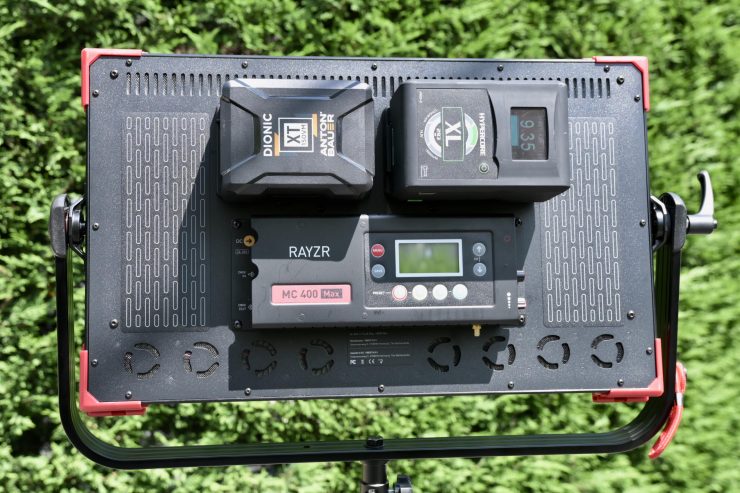
As I have already mentioned, the MC 400 MAX can be used on location without mains power, which is always handy. I like how Rayzr has integrated the V-lock battery plates on the fixture. Most people buying 1×1 or 2×1 style LED panels want to be able to attach a battery, or batteries straight onto the back of the fixture. They don’t want to be messing around with mounting brackets.
The problem I found with the V-lock battery plates is because of the way they have been positioned on the light, the left side plate has the battery release lever on the bottom side. This makes it almost impossible to remove the battery as you have to try and wedge your finger between the battery plate and the control unit to reach the lever.
Beam Angle
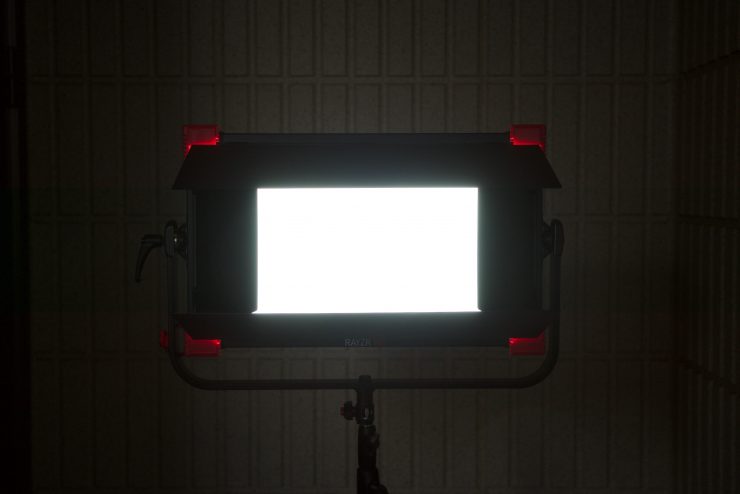
The Rayzr MC 400 MAX has a very wide 120° beam angle. Having a wide beam angle makes this fixture very versatile. The only real downside to a wide beam angle is that if you are using the lights for interviews or scenarios you need to control the spill. While this can be done fairly effectively with the barn doors, a honeycomb grid will probably get you better results.
In comparison, here is the beam angle of some of the other 2×1 RGBWW lights that are available:
- Litepanels Gemini 2×1 93°
- ARRI SkyPanel S60-C 115°
- Lupo Superpanel Full Color 60 RGBW LED Panel 120°
- LEDGO LG-G260 – LED RGB Studio Light 120°
Flicker Free
If you are shooting at high frame rates you don’t want your lights to flicker. The MC 400 MAX lets you shoot at any frame rate and shutter angle without flicker. The base frequency of the MC series can be adjusted to provide high-speed performance at any setting.
They are not Firmware Upgradable….yet.
Unlike some other RGBWW lights that are available, the RayzrMC 400 MAX is not firmware upgradable…yet. Firmware upgrades will eventually be possible, but this will need to be done either by Rayzr or a service partner. Rayzr told me that are working on making it possible through Wifi as well as by the user.
Photometrics
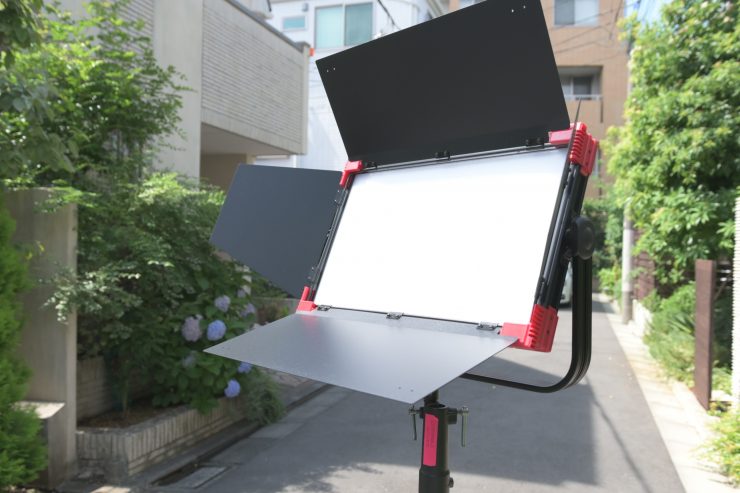
So now let’s get to the photometric results. I always test lights in this way so that I get a reference to how they compare to other fixtures. Results only tell part of the story and should never be used alone to judge a light. I have found from extensive testing over the years that certain lights that have good photometric results don’t always look good, and lights that have worse photometric scores can sometimes look better than their results indicate.
Different lights can also look different depending on what camera you happen to be using.
Output and Color Temperature Accuracy
I tested the Rayzr MC 400 MAX at a variety of Kelvin color temperatures with a Sekonic C-800 Spectrometer to find out how much output the light had and how accurate the Kelvin color temperature reproduction was. All readings are taken at a distance of 1m (3.28ft) in a controlled environment.
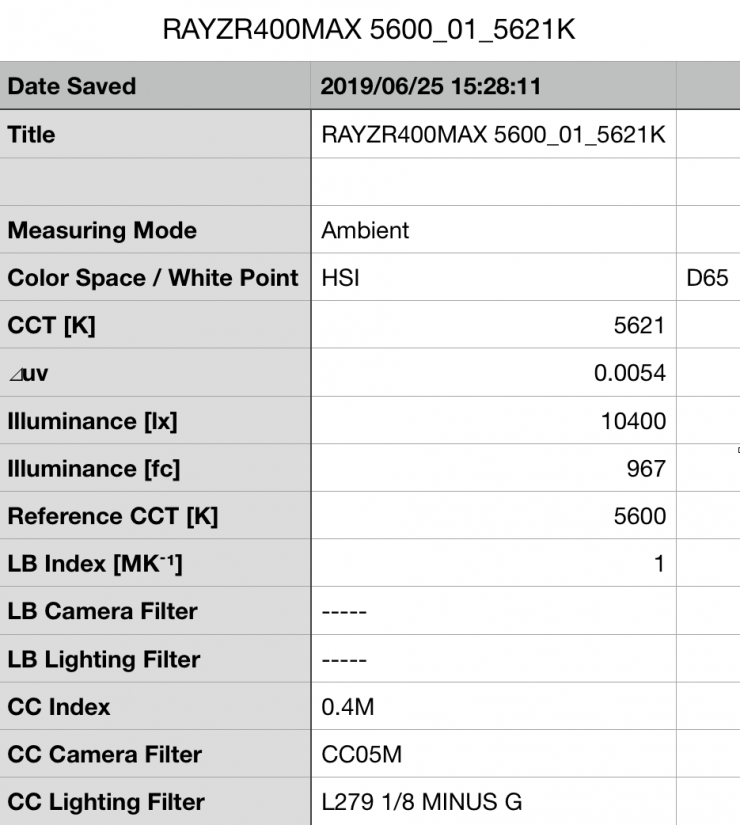
Above you can see the MC 400 MAX recorded an output of 10400 lx (967 fc) when set at 5600K and run off mains power. This is a little higher than the claimed output of 10068 lx.
Rayzr claims that it has double the output of the MC200, so does it? When I measured the MC 200 it had 4410 lx at 5600K. The MC 400 MAX has 135.8% more output.
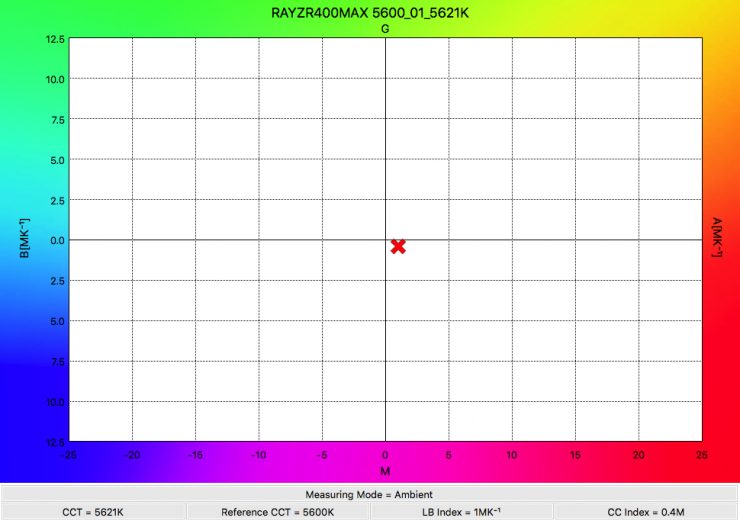
The MC 400 MAX produced a Kelvin color temperature of 5621K. The light had a CC Index score of 0.4M.
I also tested how much output the MC 400 MAX had when being run off v-lock batteries. Usually, lights have less output when being run off batteries as opposed to mains power, but the MC 400 MAX had more, with an output of 10600 lx at 5600K.
How does this compare to some other 2×1 RGB lights that we have previously reviewed:
- ARRI S60-C SkyPanel (10900 lx at 5600K)*
- Litepanels Gemini 2×1 (9970 lx at 5600K)
- LEDGO LG-G260 – LED RGB Studio Light (8140 lx at 5600K)
*There is an optional intensifier panel available for the S60-C.
Just as another reference both the Kino Flo FreeStyle 21 and Kino Flo Diva-lite 20 both put out 2409 lx at 5600K.
As far as an accurate rendition of creating a 5600K source here is how some of the other 2×1 RGB lights that we have previously reviewed fare:
- ARRI S60-C SkyPanel 5708K 0 CC
- Litepanels Gemini 2×1 5460K 0 CC
- LEDGO LG-G260 – LED RGB Studio Light 5636K
At 5600K the Rayzr MC 400 MAX has a similar output to both the Litepanels Gemini 2×1 and the ARRI SkyPanel S60-C. Its Kelvin color temperature of 5621K was more accurate than any of the other 2×1 RGB lights we have reviewed.
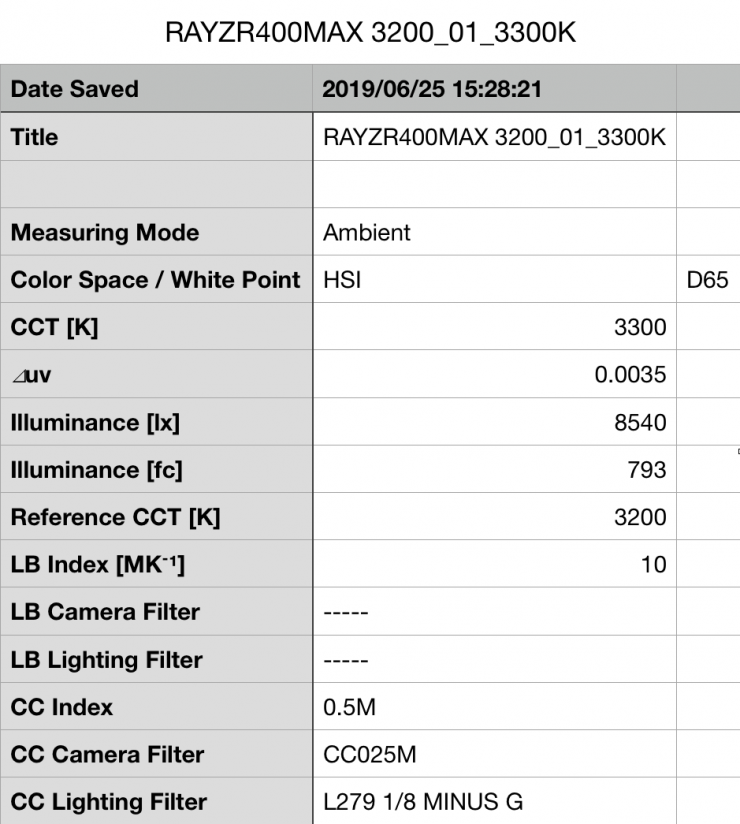
Above you can see the lights output when it was set at 3200K. It produced 8540 lx (793 fc), which is 17.9% less than the 10400 lx it produced at 5600K. As far as Kelvin color temperature accuracy goes, it recorded a fairly accurate reading of 3300K. Just like at 5600K, the reading at 3200K showed a slight push towards magenta (0.5M).
How does this compare to some other 2×1 RGB lights that we have previously reviewed:
- ARRI S60-C SkyPanel (10400 lx at 3200K)*
- Litepanels Gemini 2×1 (8970 lx at 3200K)
- LEDGO LG-G260 – LED RGB Studio Light (7420 lx at 3200K)
*There is an optional intensifier panel available for the S60-C.
Just as another reference both the Kino Flo FreeStyle 21 and Kino Flo Diva-lite 20 both put out 2409 lx at 3200K.
As far as an accurate rendition of creating a 3200K source here is how some of the other 2×1 RGB lights that we have previously reviewed fare:
- ARRI S60-C SkyPanel 3225K 0.1M
- Litepanels Gemini 2×1 3249K 0.4M
- LEDGO LG-G260 – LED RGB Studio Light 3214K
At 3200K the Rayzr MC 400 MAX has a similar output to the Litepanels Gemini 2×1, but less than the ARRI SkyPanel S60-C. Its Kelvin color temperature of 3300K was the least accurate of any of the other 2×1 RGB lights we have reviewed. In saying that, 100K is hardly a deal breaker.
+/- Green adjustment
Now, as the MC 400 MAX features +/- Green adjustment you can quite easily correct any tint. While there is no exact science to this, and it really depends on what camera you are using as well, it’s just a matter of trial and error to see what setting actually works the best. The nice thing is, any light with +/- Green adjustment can be fine-tuned to deliver better results.
How does it perform at various Kelvin color temperatures?
Summary of results
2500K – 6240 lx (580 fc) and a Kelvin color temperature reading of 2534K
3200K – 8530 lx (793 fc) and a Kelvin color temperature reading of 3300K
4500K – 9960 lx (926 fc) and a Kelvin color temperature reading of 4586K
5600K – 10400 lx (967 fc) and a Kelvin color temperature reading of 5621K
6500K – 9710 lx ( 902 fc) and a Kelvin color temperature reading of 6570K
9900K – 9550 lx (887 fc) and a Kelvin color temperature reading of 10423K
These results show me that the lights output is fairly consistent at 4500K and above. The output of the light is fairly impressive given its small size and power draw.
The results also show me that the light is very accurate when it comes to Kelvin color temperature reproduction, particularly up to 6500K.
Color Rendering
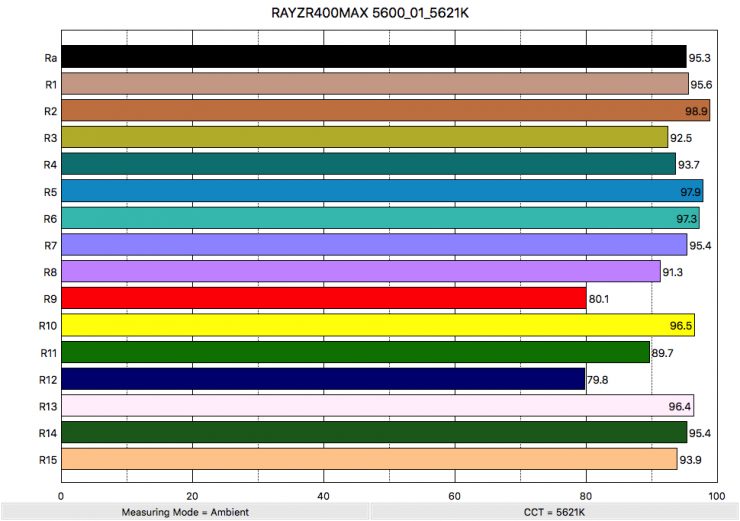
So now that we have seen how much output the MC 400 MAX produces, how does it perform when it comes to replicating accurate colors. Above you can see that when the light was set at 5600K it recorded an average CRI (R1-R8) of 95.3 and an extended CRI (R1-R15) of 92.96. For replicating accurate skin tones it recorded for R9 80.1 (red), 96.4 for R13 (closest to caucasian skin tones), and 93.9 for R15 (closest to Asian skin tones). These are pretty good results.
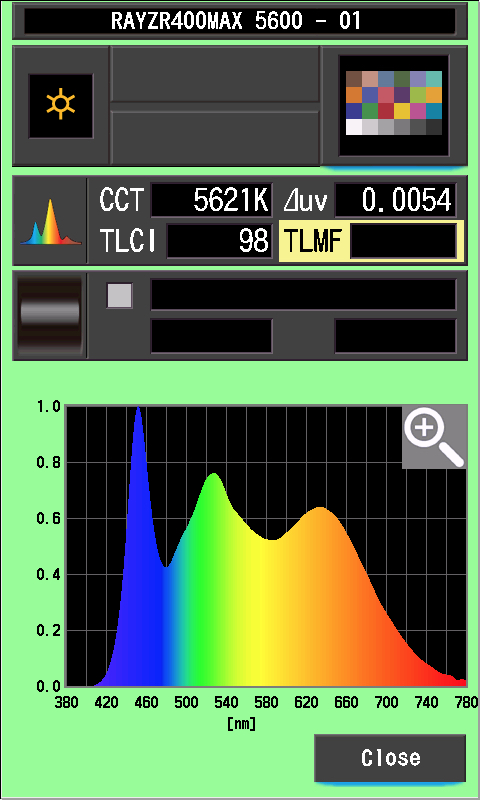
The light when set at 5600K also recorded a TLCI score of 98.
How does this compare to some other 2×1 RGB lights that we have previously reviewed:
| Litepanels Gemini 2×1 | Average CRI: 95.2 | Extended CRI: 93.24 |
| ARRI SkyPanel S60-C | Average CRI: 95.7 | Extended CRI: 92.92 |
| LEDGO LG-G260 | Average CRI: 93.1 | Extended CRI: 89.8 |
The color rendering scores of the MC 400 MAX at 5600K are very similar to other 2×1 RGBW and RGBWW lights we have reviewed
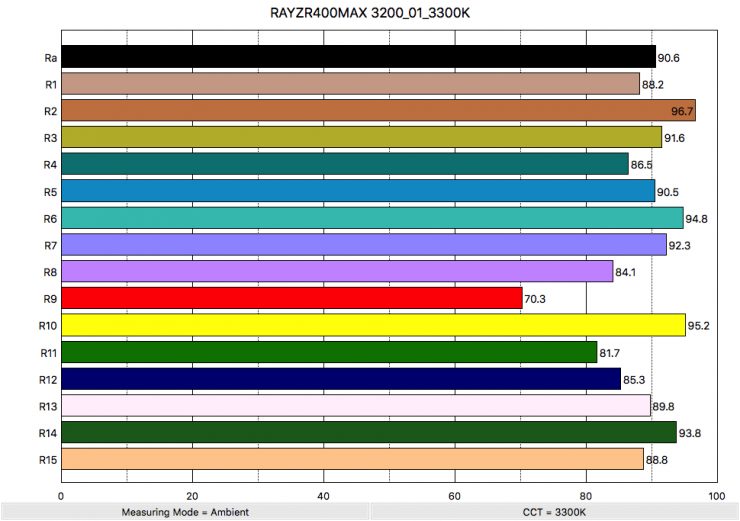
Above you can see the scores for when the light was used at 3200K. It recorded an average CRI (R1-R8) of 90.6 and an extended CRI (R1-R15) of 88.64. For replicating accurate skin tones it recorded 70.3 for R9 (red),89.8 for R13 (closest to caucasian skin tones), and 88.8 for R15 (closest to Asian skin tones).
These results were not as good as when the light is used at 5600K.
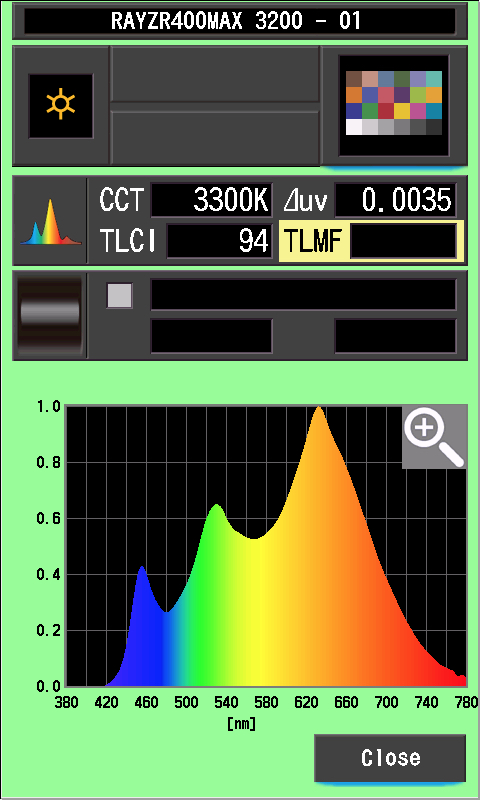
The light, when set at 3200K, recorded a TLCI score of 94.
How does this compare to some other 2×1 RGB lights that we have previously reviewed:
| Litepanels Gemini 2×1 | Average CRI: 97.2 | Extended CRI: 95.3 |
| ARRI SkyPanel S60-C | Average CRI: 96.1 | Extended CRI: 94.06 |
| LEDGO LG-G260 | Average CRI: 94.1 | Extended CRI: 91.97 |
As you can see only the MC 400 MAX had worse scores than the competition at 3200K. At 3200K all the other lights performed better than the Rayzr.
SSI
SSI (Spectral Similarity Index) was developed by the Sci-Tech Council of the Academy. SSI gives me the ability to set any light as a standard, or use predefined standards (such as CIE D55), and then give other lights an SSI score based upon how well they will match standards such as CIE D55 measure spectral response and compare it directly against an ideal light source.
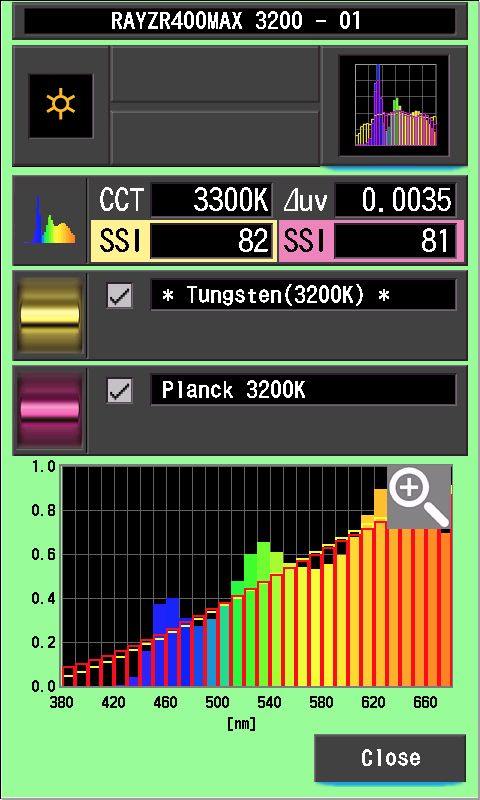
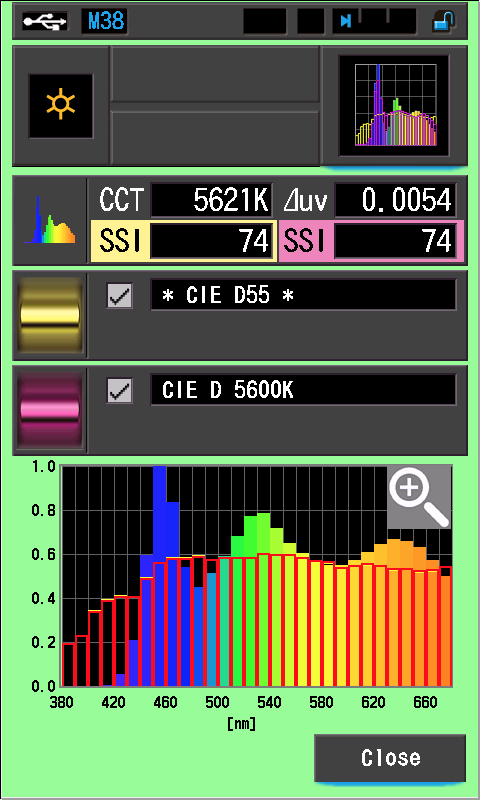
| 3200K | 5600K |
| Tungsten (3200K): 82 | CIE D55: 74 |
| Planck 3200K: 81 | CIE D 5600K: 74 |
This is useful to see how well different lights will play together. As the Sekonic C-800 Spectromaster can measure SSI, I decided to test out the MC 400 MAX to see how it performed. Above are the scores for the light when used at 3200K and 5600K. The scores show that the light does a pretty good job of accurately replicating a 3200K (Tungsten) source, but it’s not as good at replicating a 5600K source. In saying that, it is important to note that most LED lights only record SSI scores in the 70s when they are used at 5600K.
The main reason we want to record SSI scores is so we can see how well they match with other lights. I was curious to see how well the Rayzr MC 400 MAX matched the Rayzr MC 200. Below you can see the results.
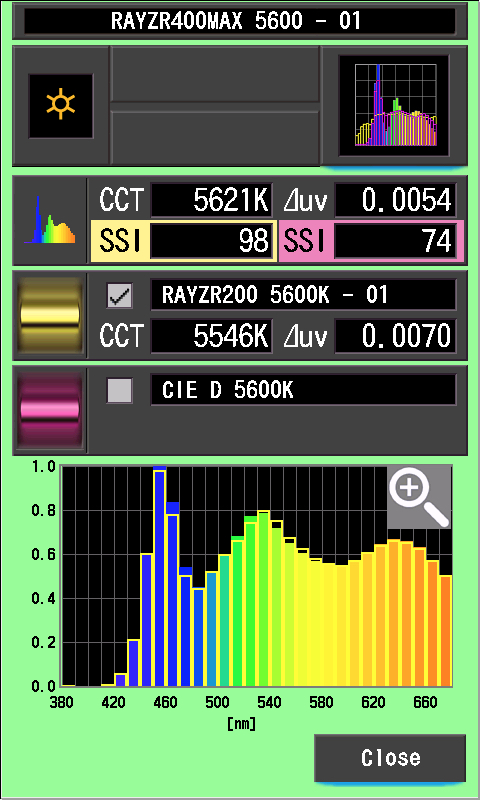
As you can see the MC 400 MAX and MC 200 are almost a perfect match when used at 5600K.
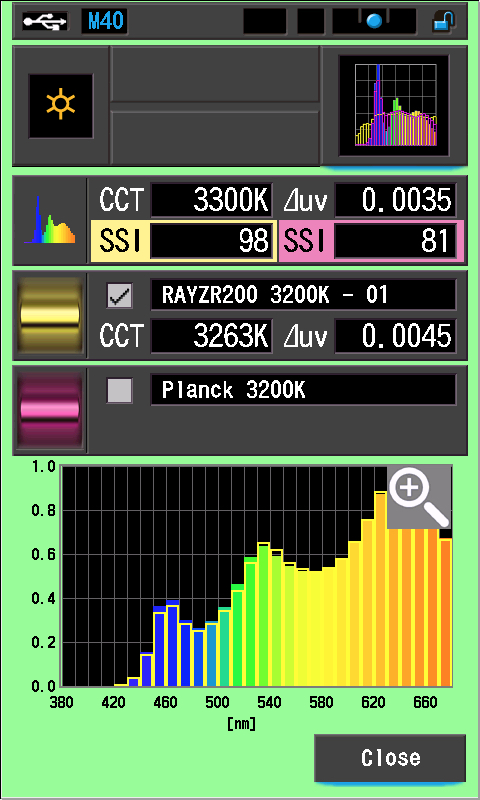
At 3200K the MC 400 MAX and MC 200 again have an SSI score of 98.
This shows me that you can use the Rayzr MC series lights and have the confidence that they are almost an identical match. This means you won’t get any nasty surprises on set.
Spectral Distribution
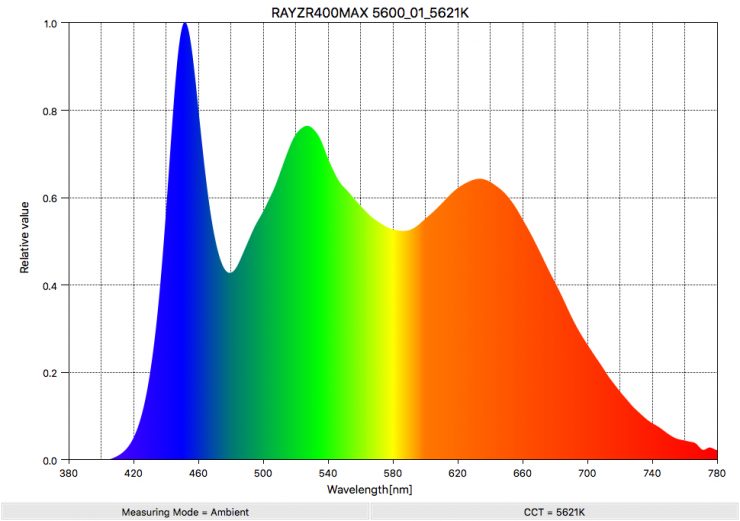
Above you can see the spectral distribution of the MC 120 when it is set at 5600K. The spectral distribution, while reasonably full has quite a few spikes in it.
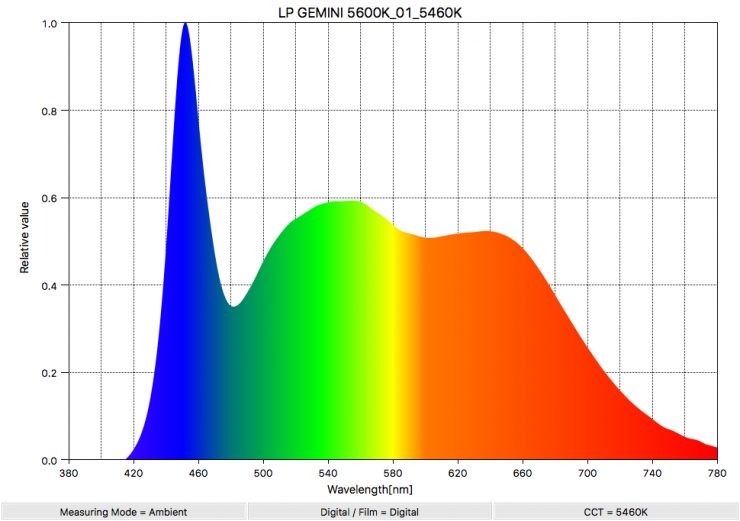
As a comparison, above you can see the spectral distribution of the Litepanels Gemini 2×1 when it is set at 5600K. The spectral distribution is not quite as full as that of the MC 400 MAX, but there aren’t nearly as many spikes.
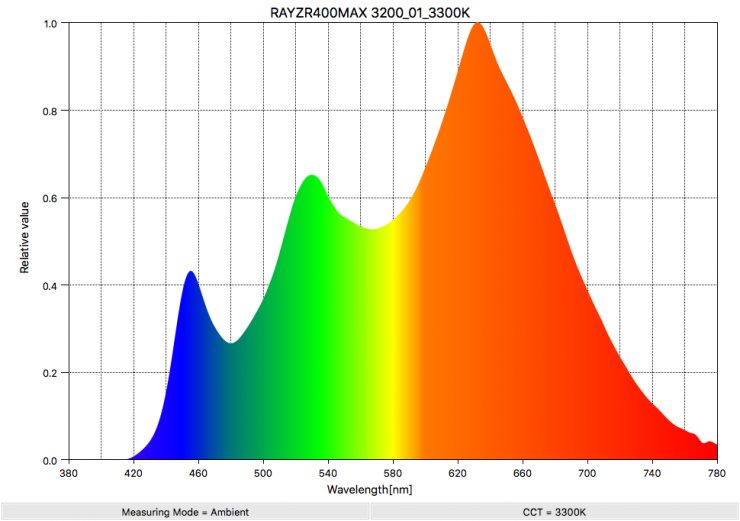
Above you can see the spectral distribution of the MC 400 MAX when it is set at 3200K. The spectral distribution certainly has a green spike and it’s also missing some color information in parts of the spectrum.
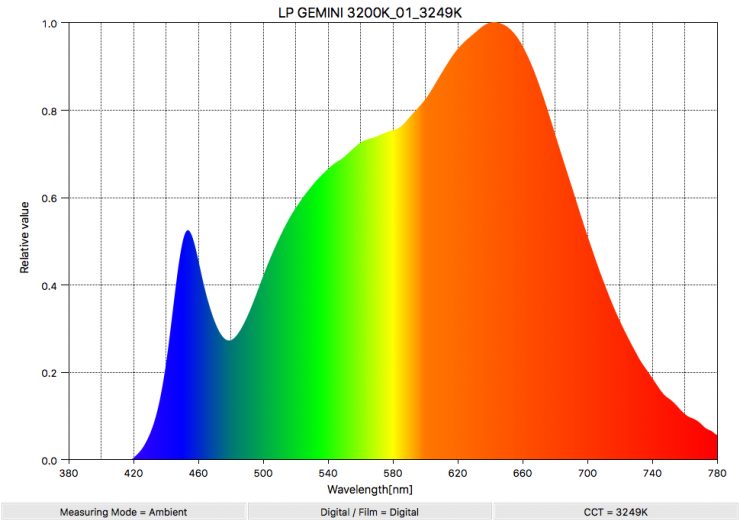
Again as a comparison, above you can see the spectral distribution of the Litepanels Gemini 2×1 when it is set at 3200K. As you can see, the Litepanels has a much better spectrum when used at 3200K.
Real-World Performance and Quality of Light
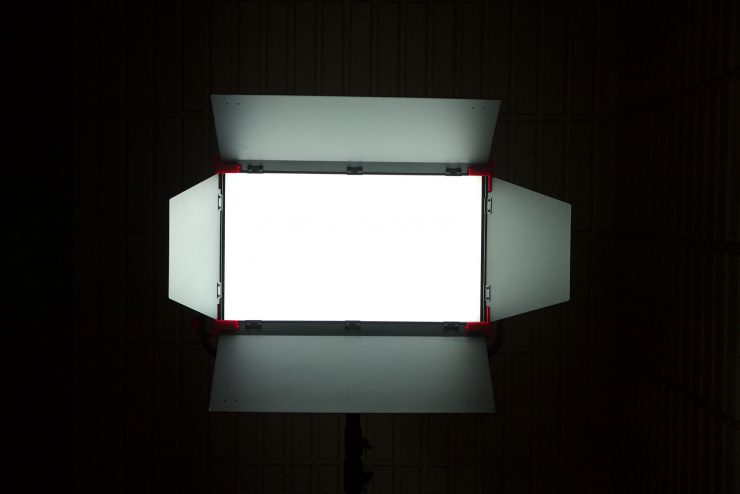
As I always say, photometric scores only tell you part of the story. So do the scores from the MC 400 MAX translate into real-world performance? The simple answer is yes. The quality of the light that is coming from the MC series is pretty much on par with a lot of other 2×1 style RGBWW light I have tested.
As far as how the light looks, it has the exact same characteristics at the MC fixtures, but with a far greater output. If you are interested in seeing how it looks on skin tones you can check out my previous Rayzr MC series test here.
The very wide beam angle certainly makes it a very versatile fixture. You can use it to indirectly bounce light into a ceiling or a wall and it produces a nice indirect lighting source. If you just need brute power it also works well.
I like that I can use the lights via mains power or through V-lock camera batteries without any limitations on the output.
The MC series probably lean a little more magenta than the Litepanels Gemini 2×1, but you can easily dial this out.
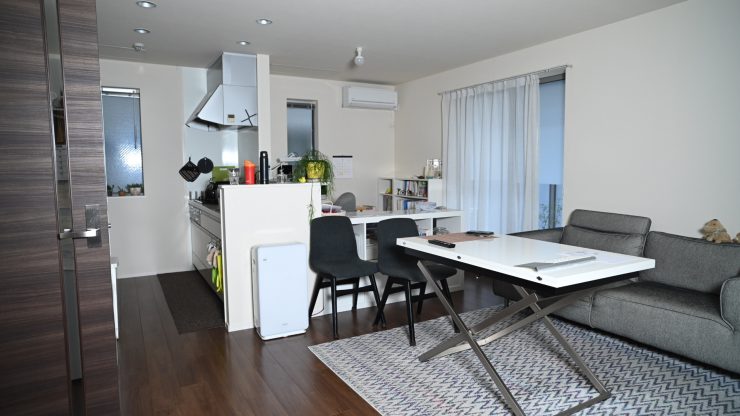
Rayzr MC 400 MAX 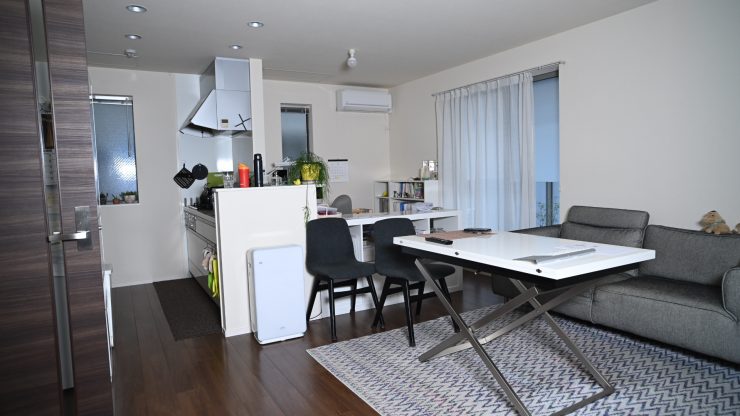
Litepanels Gemini 2×1
Above you can see a simple comparison in terms of output and the lights beam angle when compared against the Litepanels Gemini 2×1. Both lights were set at 5600K and are at 100%.
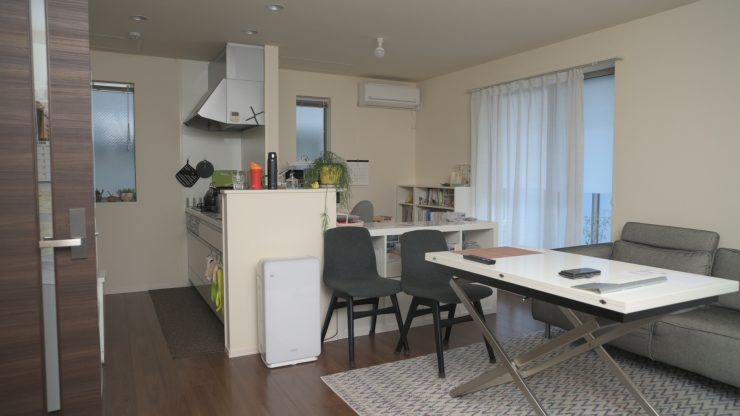
Liepanels Gemini 2×1 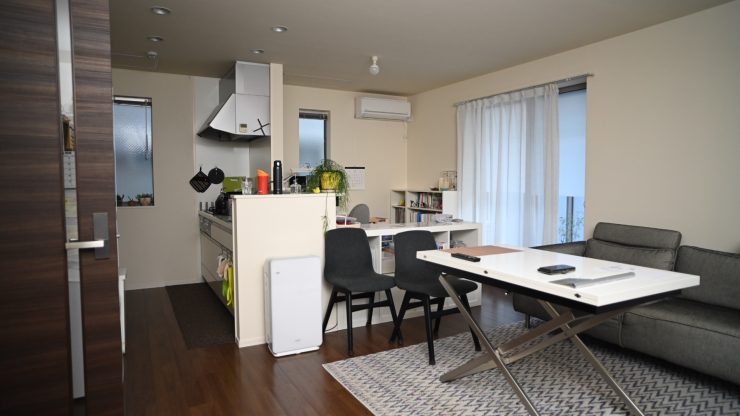
Rayzr MC 400 MAX
Above you can also see how both lights look when they are punched directly into the ceiling.
In terms of real-world output, the Rayzr MC 400 MAX is on par with the Ltepanels Gemini 2×1.
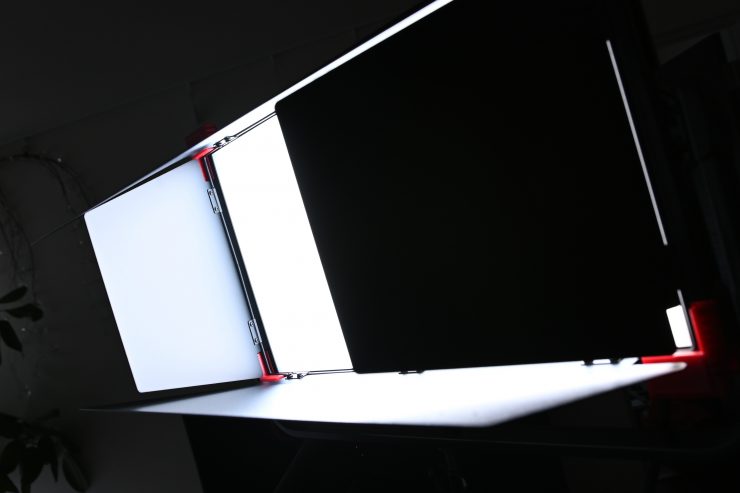
The MC 400 MAX is certainly a very versatile lighting tool that offers a lot of functionality, as well as output, that doesn’t come at the cost of accuracy. Too often I have seen lights where they have concentrated too much on features and gimmicks which have come at the expense of the quality of light.
While there are a lot of features in the MC 400 MAX there is a good proportion of users that may never find themselves actually using them, but they are nice to have at your disposal. The key features for me are the CCT Mode (Correlated Color Temperature) where you can add or subtract green and the built-in gels. These are the two real-world features that will be the most commonly used.
Being able to create a range of different colors can be handy for certain applications, and having inbuilt effects like Fire, Lightning, Paparazzi, and Strobe are also fun, but again they are not something most people are going to use that often.
Who is the MC 400 MAX aimed at?
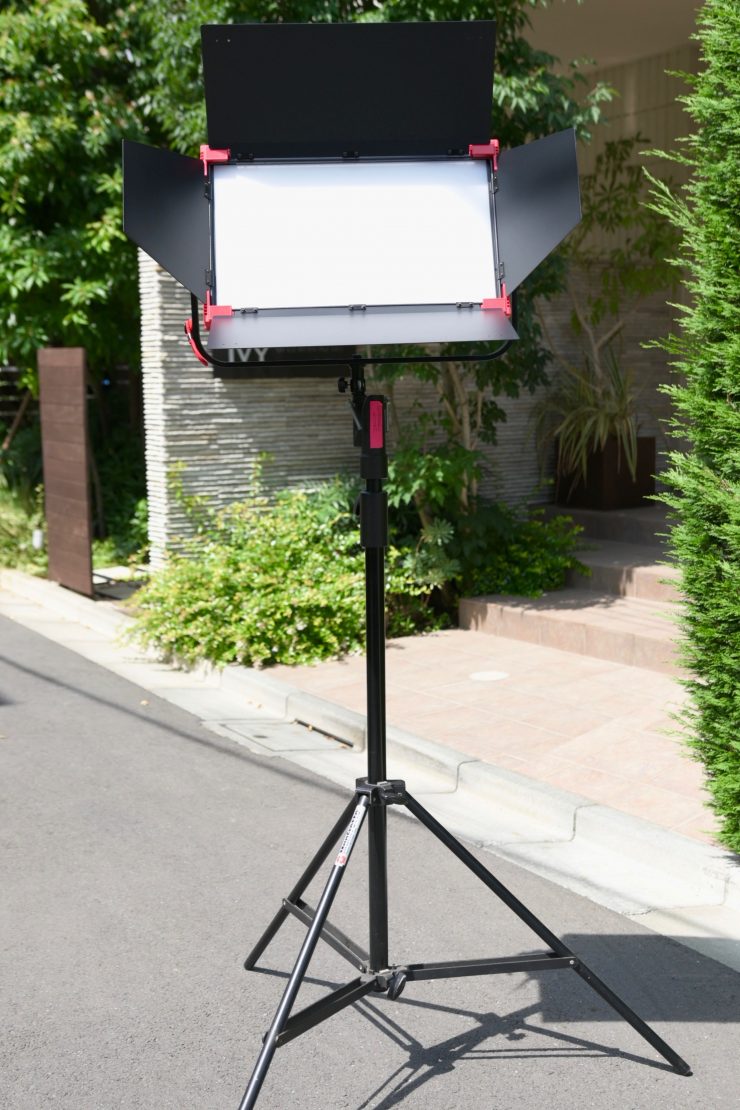
You could use the MC 400 MAX for lots of different applications, but the light is certainly being targeted as a high output, portable light source that can be used either indoors or outdoors.
The MC 400 MAX is being targeted at the same market that would consider a 2×1 sized ARRI SkyPanel, a Litepanels Gemini, or a Lupo Superpanel 60.
Whether the MC 400 MAX is likely to appeal to solo shooters and small crews who are looking for a travel-friendly and affordable RGBWW solution is debatable. I personally think it could be used in that capacity given its output, with the only real caveats being the power draw and weight. I personally wouldn’t travel with a light this size, but it could be done.
Other Alternatives
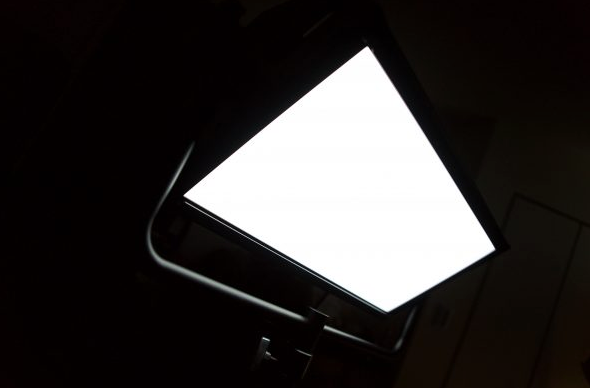
As I have already mentioned numerous times throughout this review the main competition for the MC 400 MAX comes in the form of the:
- Litepanels Gemini 2×1
- ARRI SkyPanel S60-C
- LEDGO LG-G260
- Lupo Superpanel Full Color 60
- Kino Flo FreeStyle 21
- Kino Flo Diva-lite 20
The Rayzr MC 400 MAX is very similar to the Litepanels Gemini 2×1, ARRI SkyPanel S60-C, LEDGO LG-G260 , and the Lupo Superpanel Full Color 60 in terms of output, specifications, and features.
The two Kino Flo options, while offering similar functionality don’t have nearly the output of any of these other lights.
All of the competition have their strengths and weaknesses and what light will work best for you certainly comes down to a lot more factors that just specifications and features.
A rental house is much more likely to carry an ARRI, Kino Flo, or even a Litepanels Gemini over a Lupo, Ledgo, or a Rayzr. This is primarily to do with the build quality, after-sales service, and a long term track record of reliability.
Price & Availability
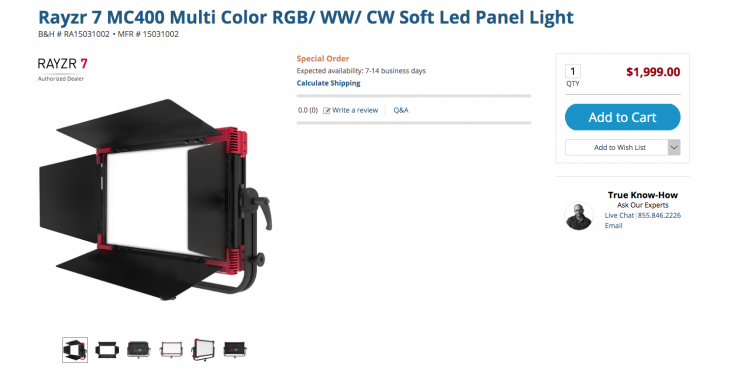
The Rayzr MC 400 MAX is certainly priced very aggressively against its main competition.
The Rayzr 400 MAX retails for $1,999 USD.
So how does this price compare to the competition:
- Litepanels Gemini 2×1 $4,512.50 USD
- ARRI SkyPanel S60-C $5,850 USD
- LEDGO LG-G260 $2,423 USD
- Lupo Superpanel Full Color 60 $2,598.00 USD
- Kino Flo FreeStyle 21 $1,015.75 USD
- Kino Flo Diva-lite 20 $1,881.25 US
As you can see the MC 400 MAX is considerably more affordable than the competition. I have listed the Kino Flo FreeStyle 21 and Kino Flo Diva-lite 20 above, but neither fixture has anywhere near the output of any of the other lights on the list.
Conclusion
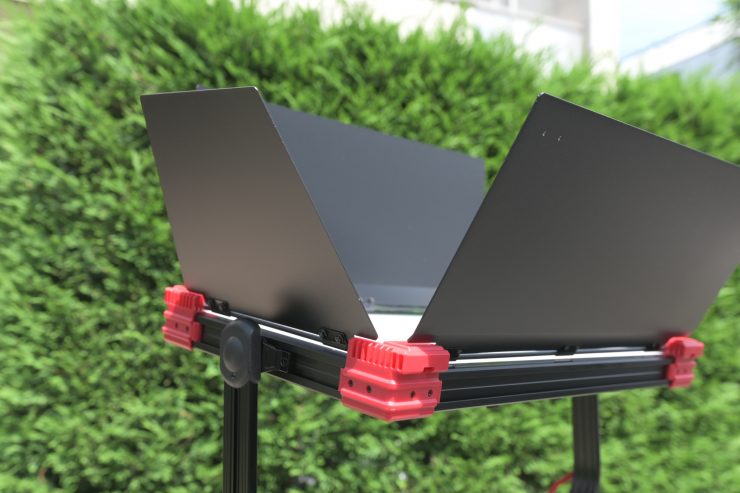
The Rayzr MC 400 MAX certainly offers very good value for money, and the fixture is substantially more affordable than all the other high output RGBWW lights that are available.
The light is well built, fully-featured and produces a really nice quality of light. The color rendering scores are good and the output is on par with its closest competition.
While it is nice to have RGBWW capabilities, special effects, and built-in filters, I personally don’t tend to use those features very often. In saying that, it is always handy to have them on tap just in case you do need them.
Is it a practical light for solo shooters, no. While its relatively lightweight for a fixture of this size and its ability to run off camera batteries remotely in the field is great, you do have to take into account the high capacity batteries you will need to power it. If you fly a lot, then this definitely some drawbacks to owning a light of this size, but that goes for just about any large fixture.
I like that the fixture comes with built-in battery plates and barn doors and that the yolk frame and locking mechanism are well made. The real elephant in the room is the large, heavy, separate power supply. Even though I am complaining about it, it’s still lighter than the one that comes with the SkyPanel S60-C.
The MC 400 MAX is good follow up to the previously released MC 100, MC 120, and MC 200. All of the Rayzr MC series, including the MC 400 MAX, offer a good balance of performance and features at a reasonable price.
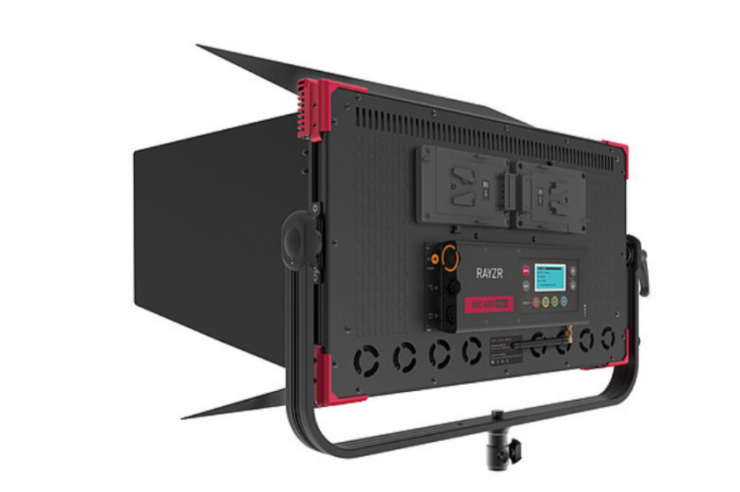
If you are after a high output 2×1 RGBWW light that can be run at full power off camera batteries, then the MC 400 MAX is definitely worth looking at.

